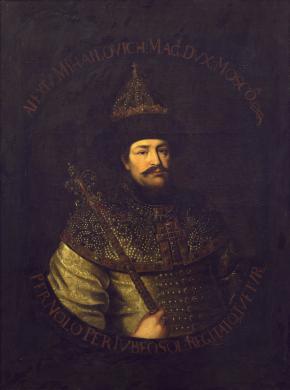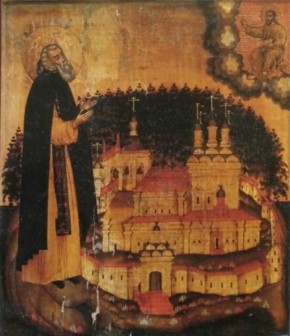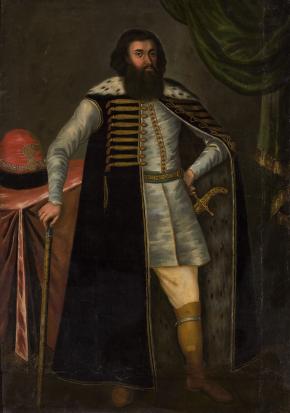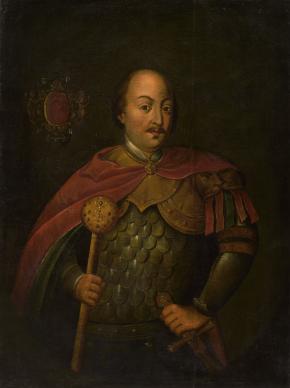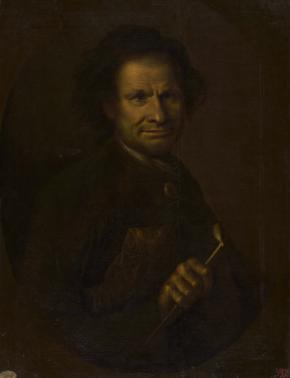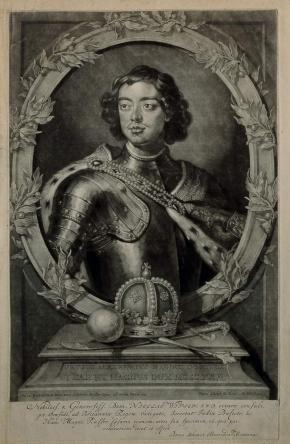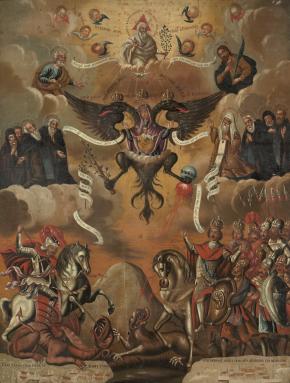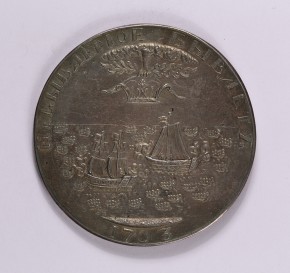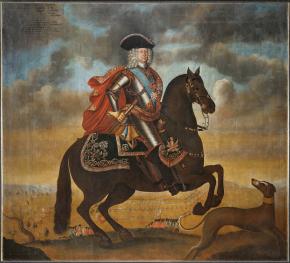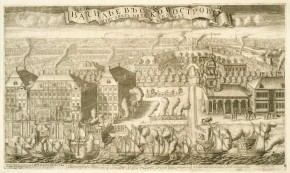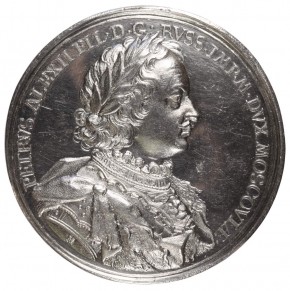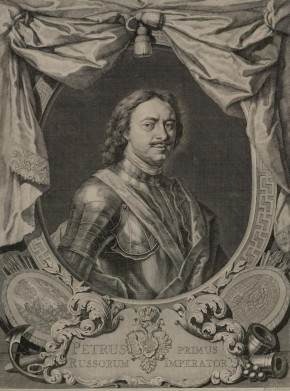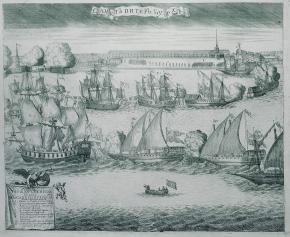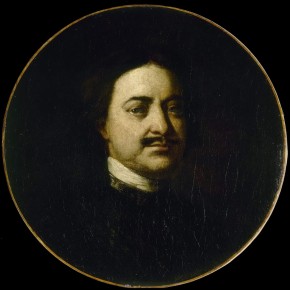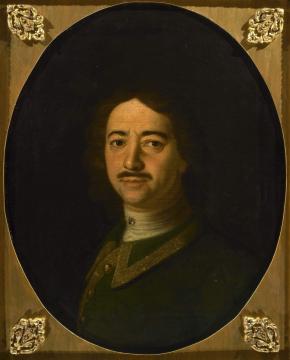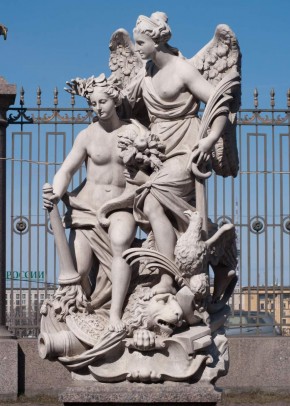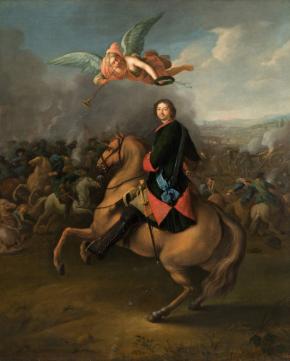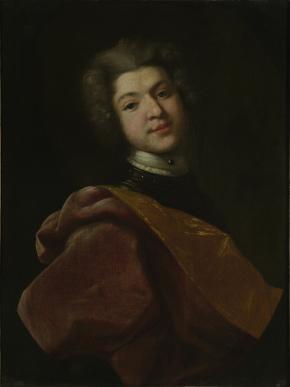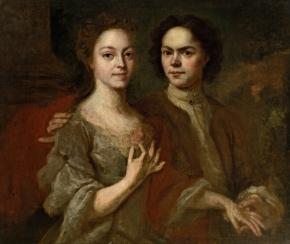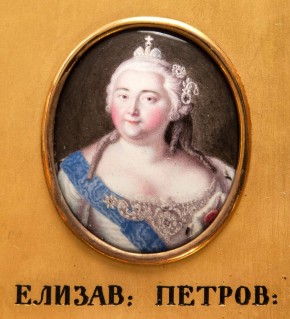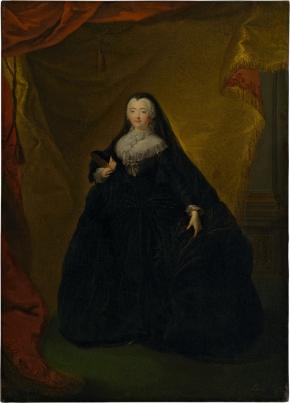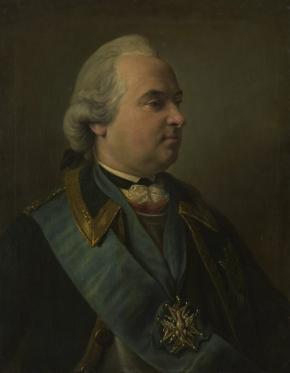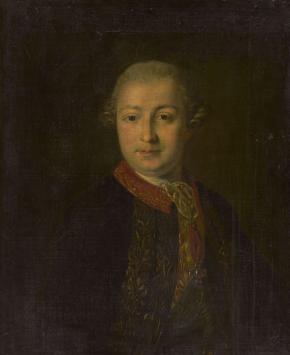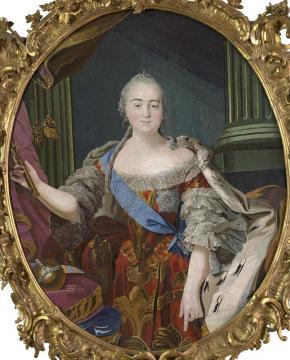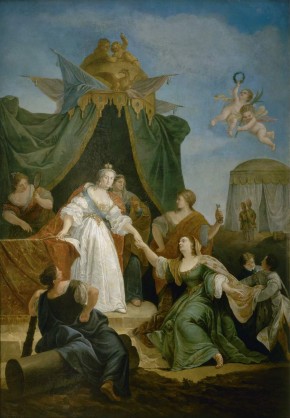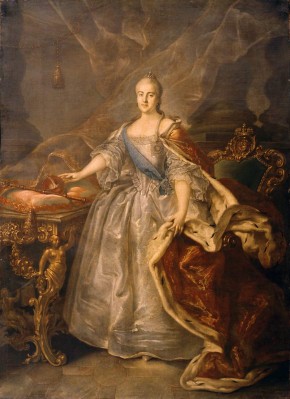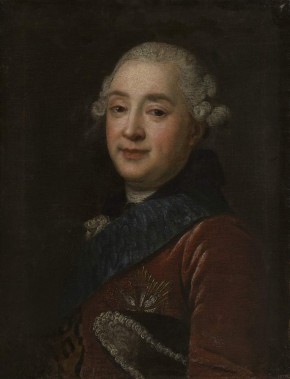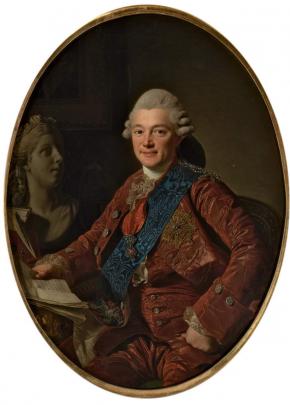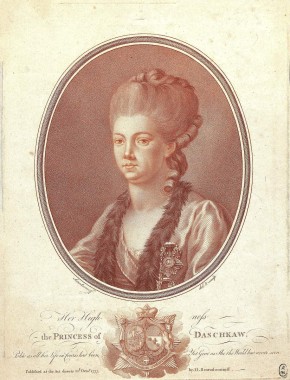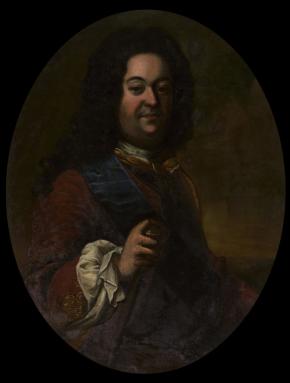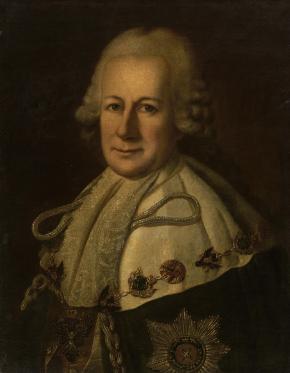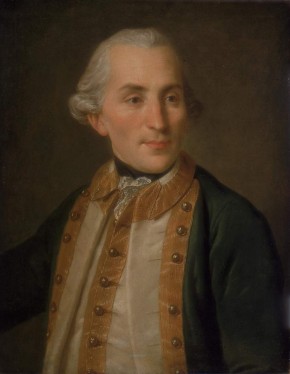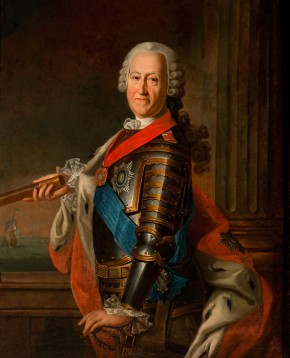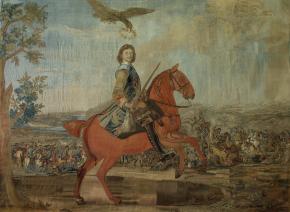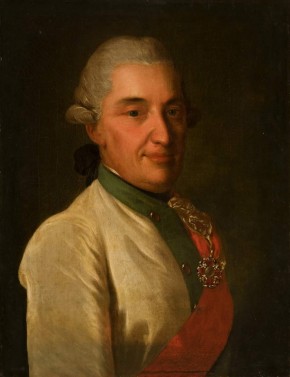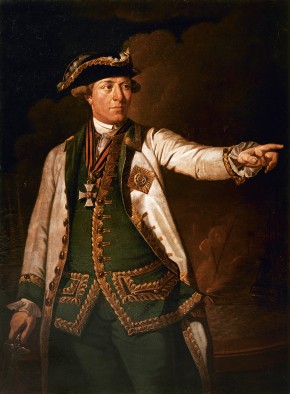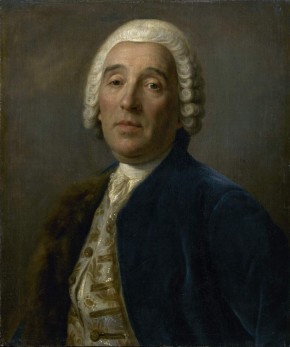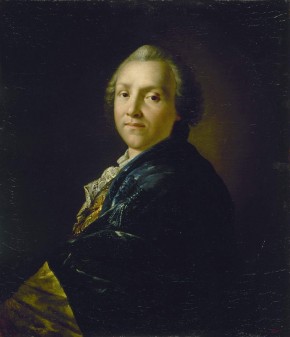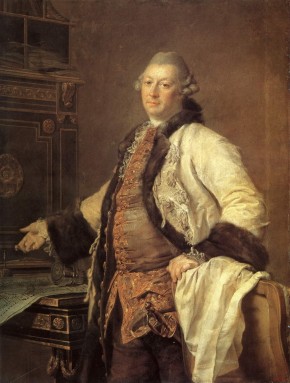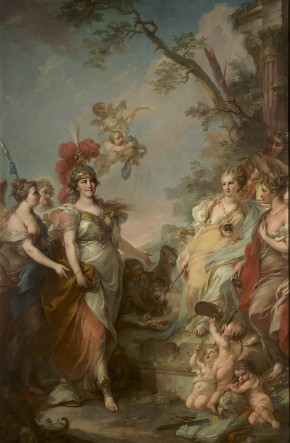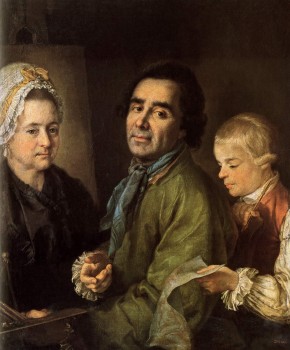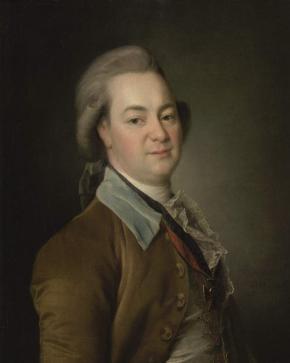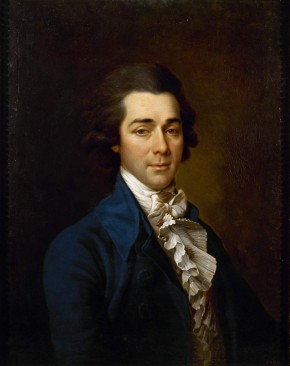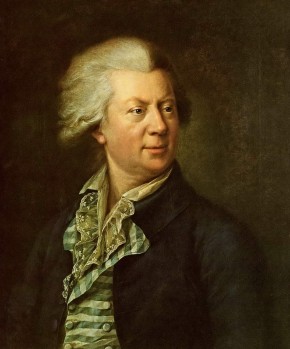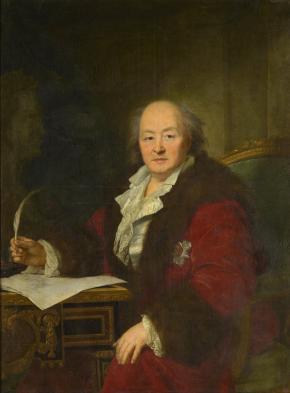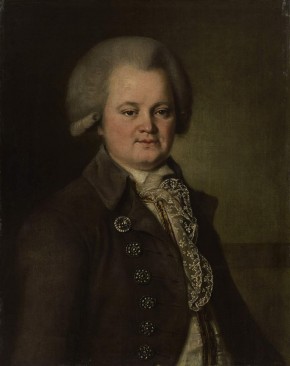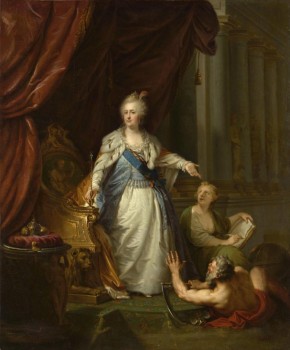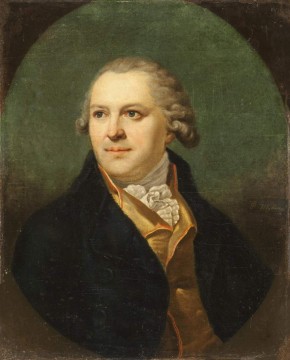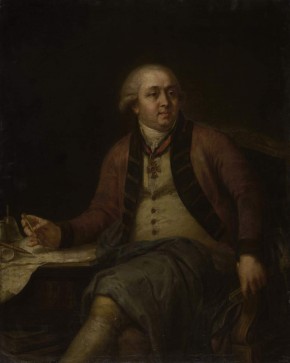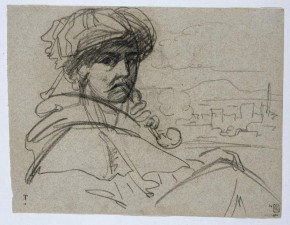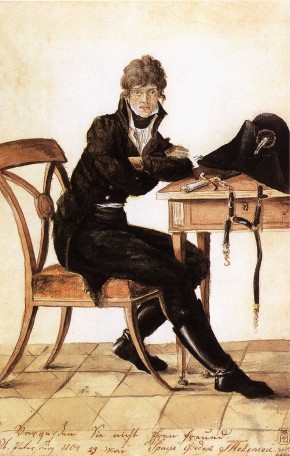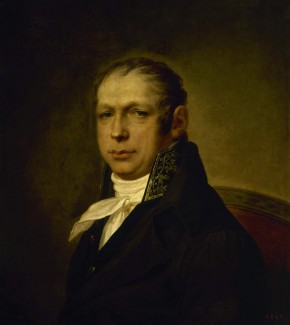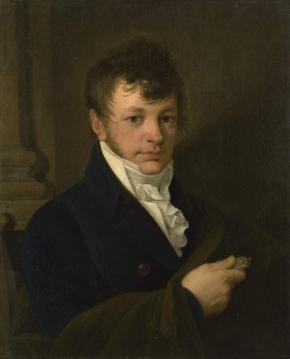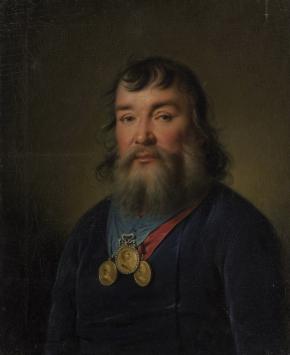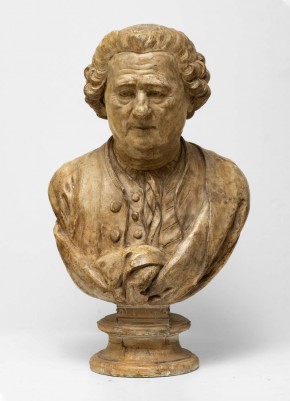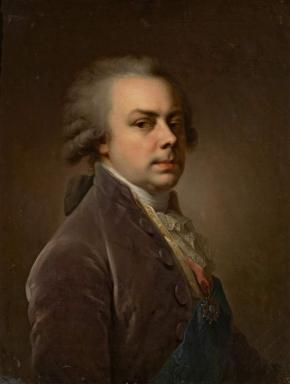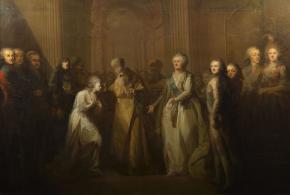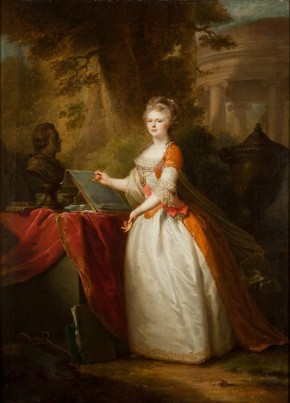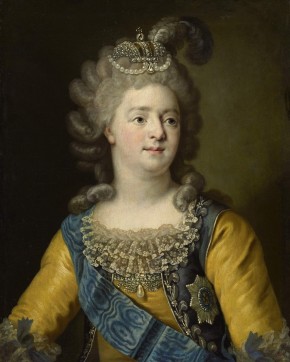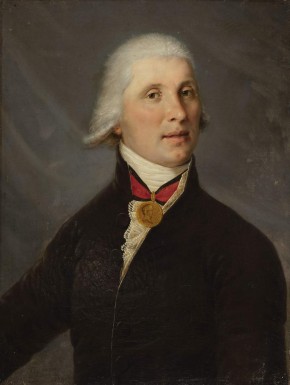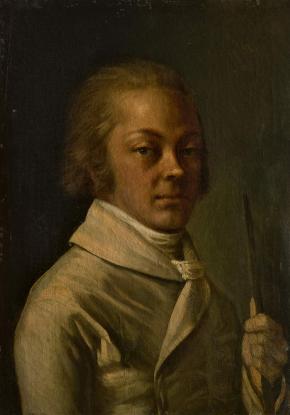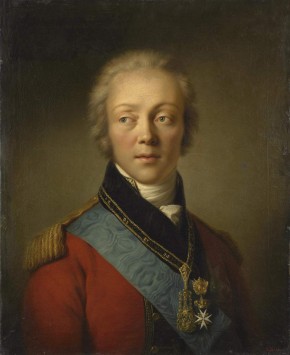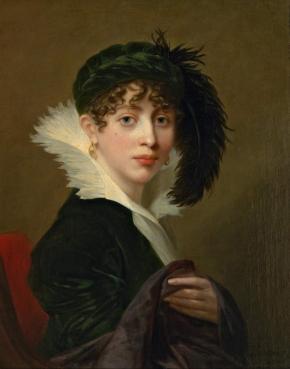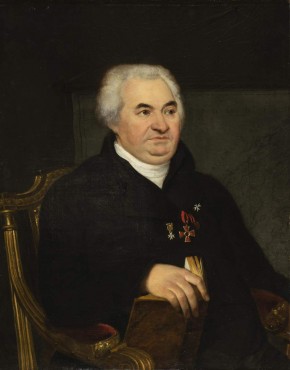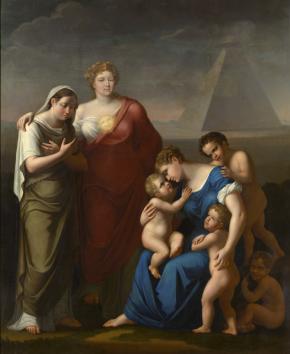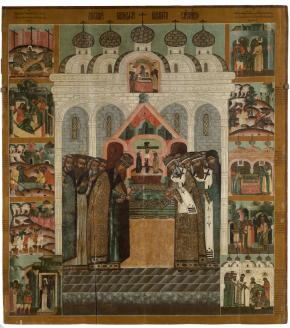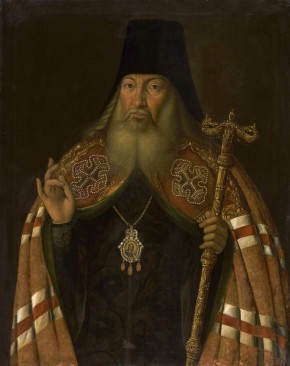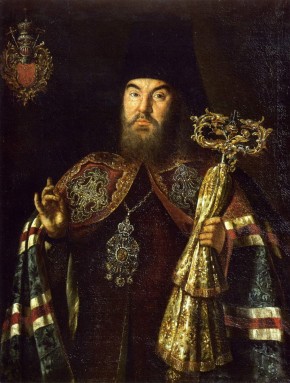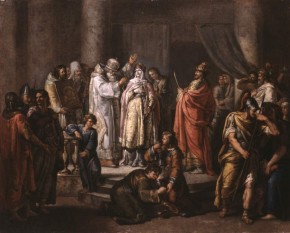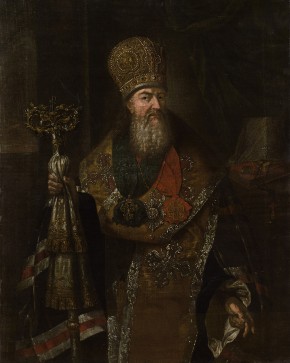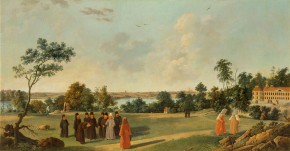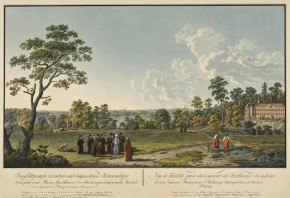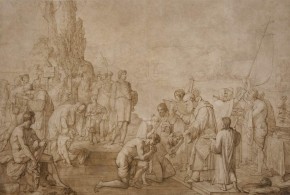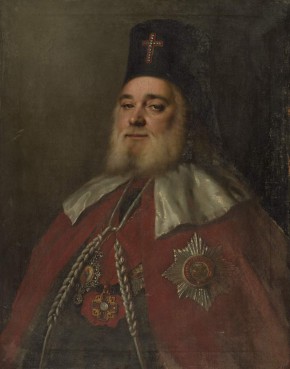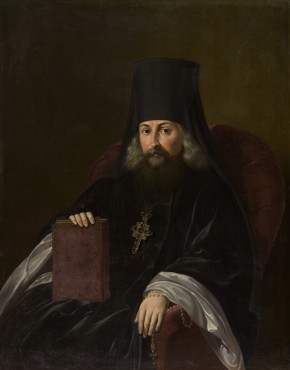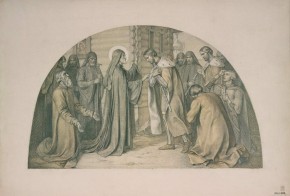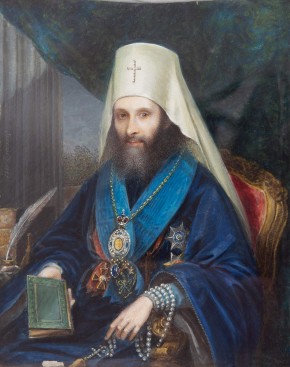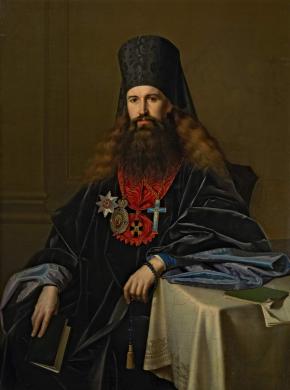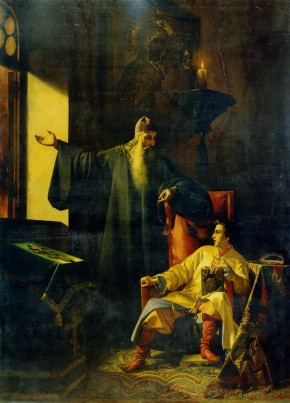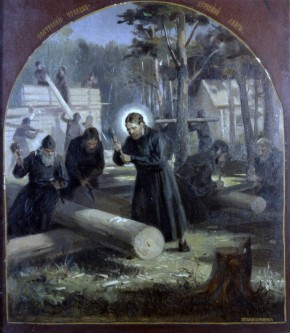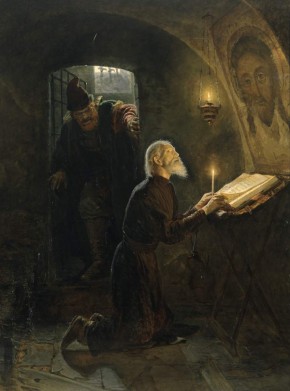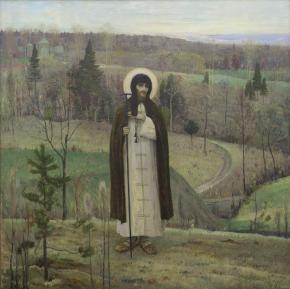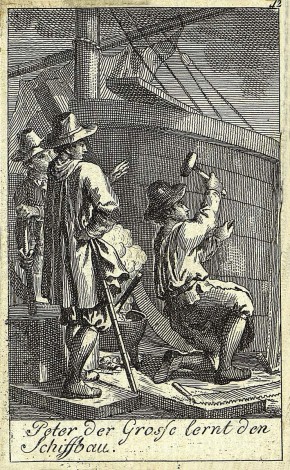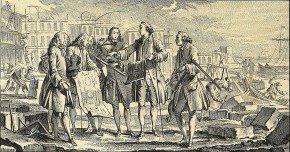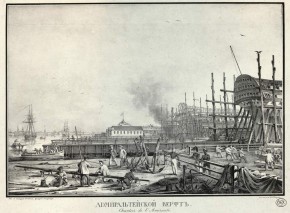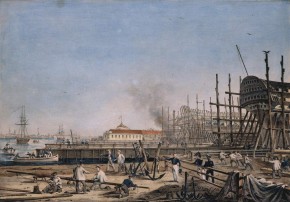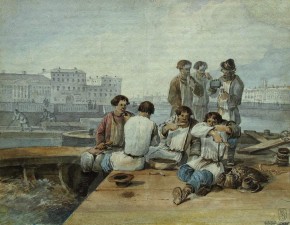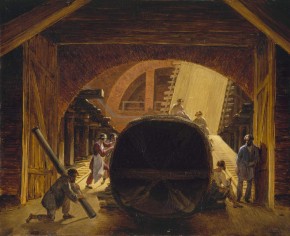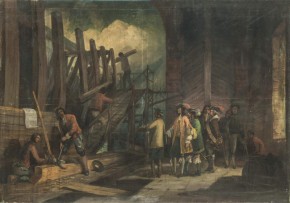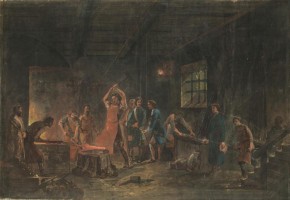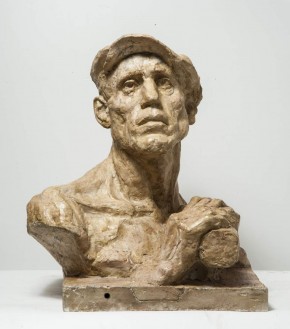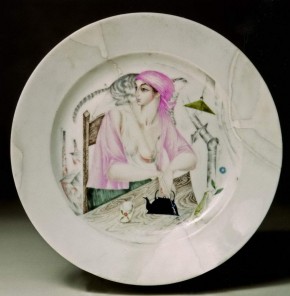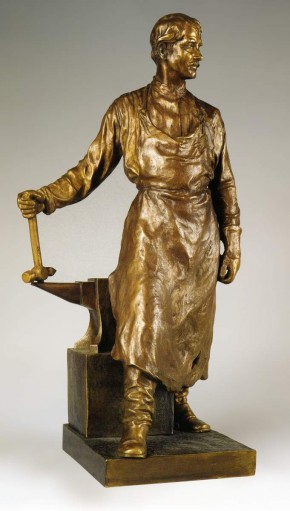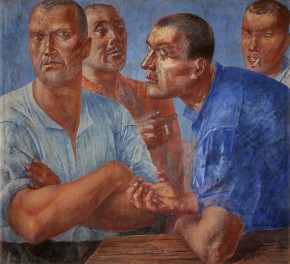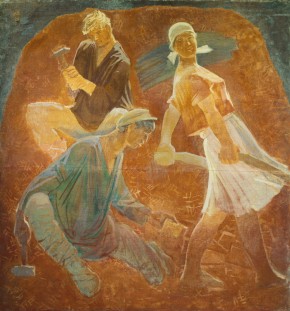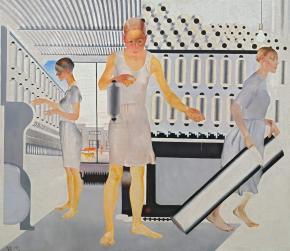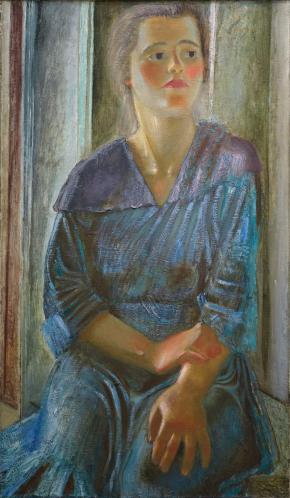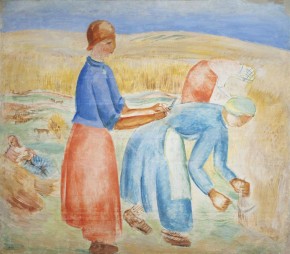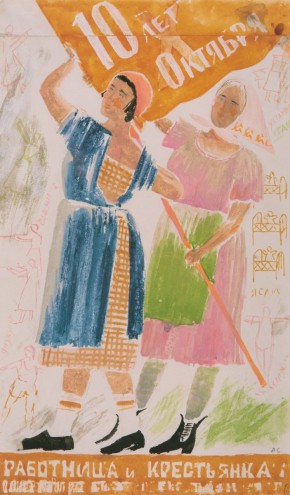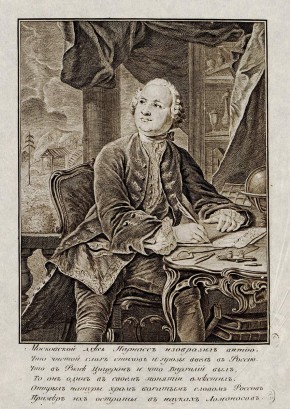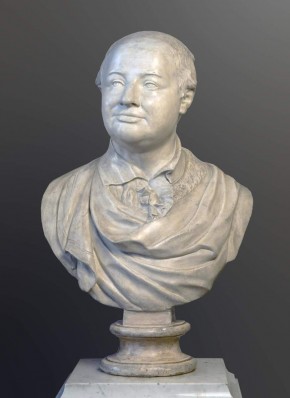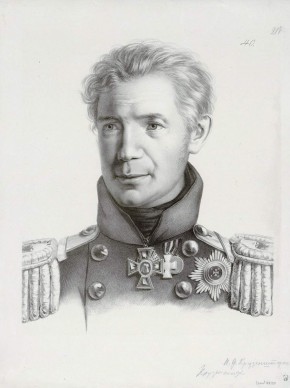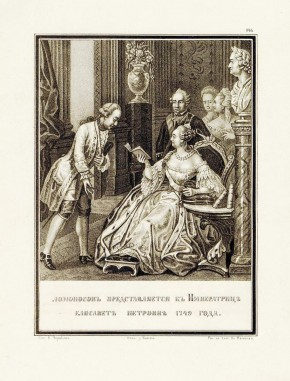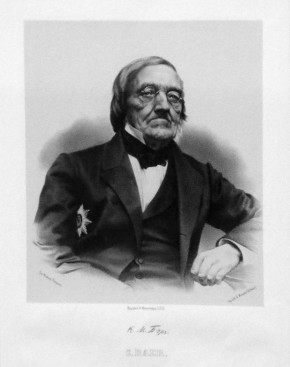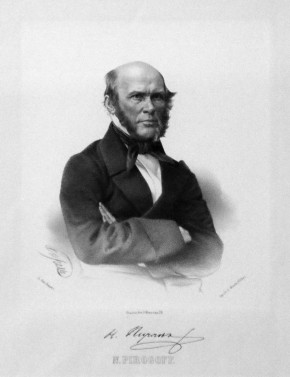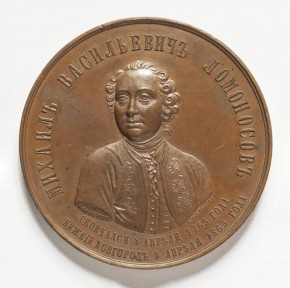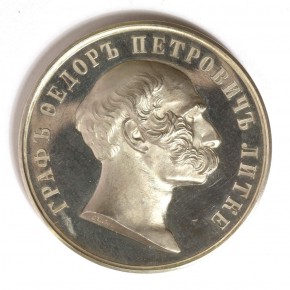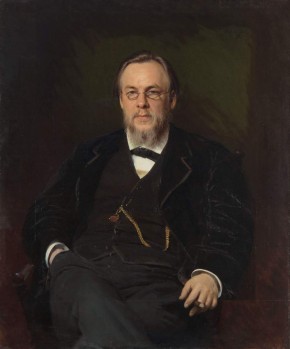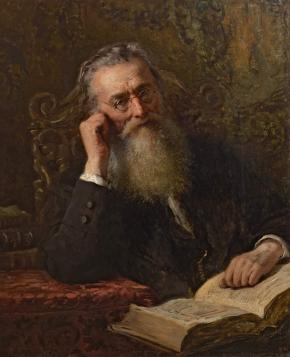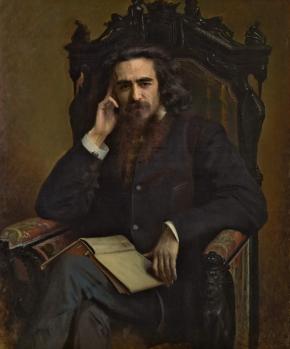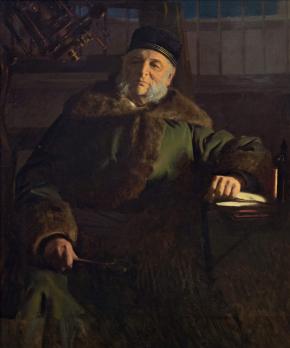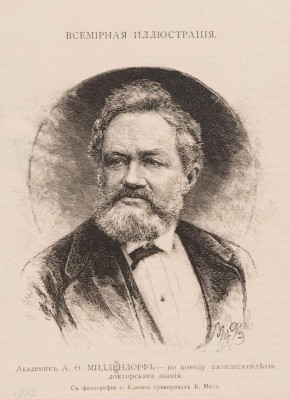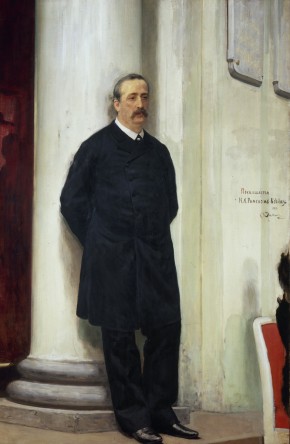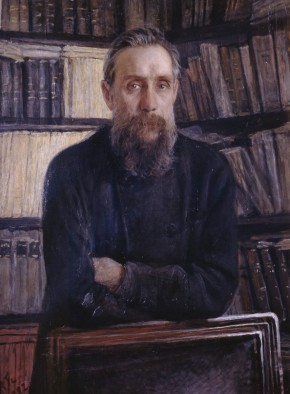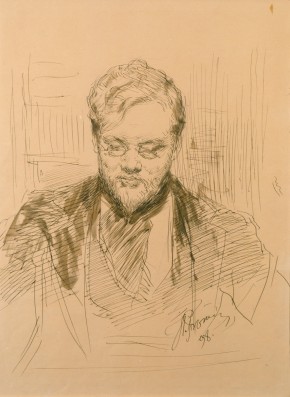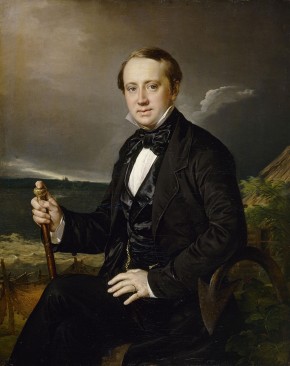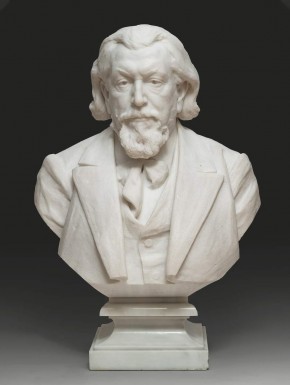Advanced search collections
For the Glory of the Fatherland
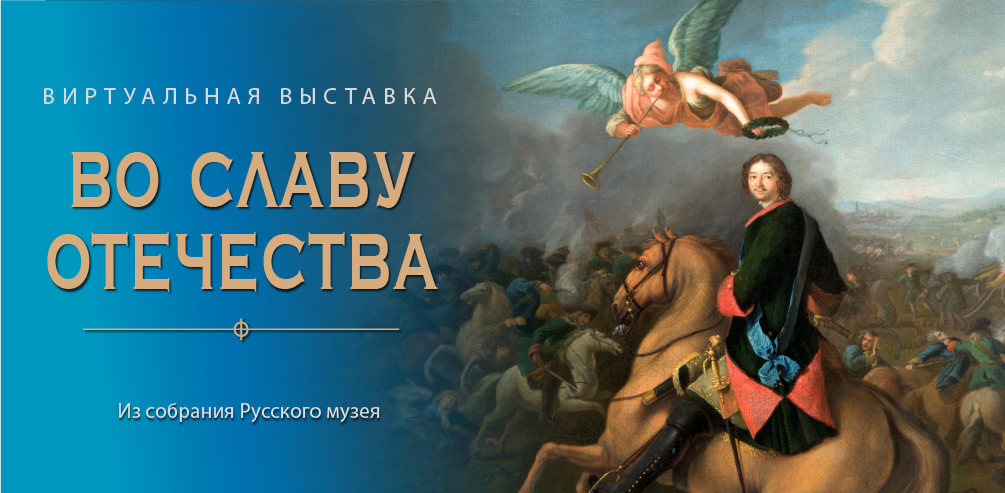
The virtual exhibition is dedicated to the most important events in Russian history and to people whose lives and works were devoted to the prosperity of Russia. The virtual exhibition includes paintings, graphics, sculptures, medallions and decorative and applied art from the collection of the Russian Museum, created over several centuries.
Portrait of Tsar Alexis Mikhailovich
- Before 1671 (?)/ After 1676 (?)
- Canvas, oil.
- The State Russian Museum
- Ж-3988
Alexis I Mikhailovich (March 19, 1629 – January 29, 1676)
Tsar, member of the Romanov dynasty, father of Peter the Great. Son of Mikhail Fedorovich and Eudoxia Streshneva. He assumed the throne on July 14, 1645, and was crowned on September 28, 1645. During his reign the Zemsky Sobor (Assembly of the Land) passed the Law Code of 1649; the Customs (1653) and New Trade (1667) Regulations were adopted; and Ukraine came under Russian rule (1654), which led to the signing of the Truce of Andrusovo between Russia and Poland (1667). On January 16, 1648 Alexis married Maria Ilyinichna Miloslavskaya (April 1, 1624 – March 3, 1669), together they had 13 children. On January 22, 1671 he entered into a second marriage with Natalia Naryshkina (August 22, 1651 – January 25, 1694), and had three children with her: Peter (May 30, 1672 – January 28, 1725), Natalia (August 22, 1673 – June 18, 1716), and Feodora (September 4, 1674 – November 28, 1678).
This portrait engraved by Cornelis Meyssens (1646–?) can be found among illustrations of the book Historia di Leopoldo Cesare (History of Leopold Caesar, Vienna, 1670); that is where its traditional dating comes from. However, an inscription made on the portrait “reigned and ruled” (in Latin, in the past tense) suggests that the portrait was made after the tsar’s death. The artist’s alterations and technical characteristics do not contradict the fact that the work was painted in the end of the 17th century.
Александр Свирский
- Wood, tempera, , .
- The State Russian Museum
- ДРЖ-907
Portrait of Prince Anikita Repnin
- Late 1690s
- Canvas, oil. 181 х 128
- The State Russian Museum
- Ж-3947
Anikita Repnin (1668 – July 3, 1726). Middle son of Ivan Repnin (1615– 1697) who was a boyar close to the tsar and a house steward of Tsar Alexis Mikhailovich, and Ivan’s wife Yevdokia Nikiforovna Pleshcheyeva (? – April 8, 1695). Russian Field Marshal General (1725). From his early years Anikita was close to Peter the Great and took part in the creation of the emperor’s Toy Army. In 1685 he became Lieutenant and within two years he was promoted to Colonel. Repnin participated in the Azov campaigns of 1695–1696. In 1696 he commanded a frigate. In 1699 he became Major General. In the beginning of the Northern War he commanded a division. Following the order of Peter the Great he reconstituted Russian forces withdrawing from Narva after they were defeated in 1700. He took part in the Siege of Nöteborg (1702) and Narva (1704). During the Battle of Poltava (1709) he commanded the centre of the Russian troops. During the years 1709–1710 he commanded the siege and the seizure of Riga. During the years 1712–1713 and 1715–1716 he commanded troops in Pomerania. In 1719 he was appointed Governor General of Livonia, and at the same time he acted as President of the Military College from 1724–1725. After the death of Peter the Great, he supported the enthronement of Catherine I, but shortly afterwards Alexander Menshikov sent him away to Riga.
From the second half of the 19th century to the early 21st century almost all scholars believed the person depicted here to be Ivan Borisovich Repnin; however, this traditional view was recently reconsidered. In 2014 a new version was accepted by the Attribution Council of the Russian Museum.
Portrait of Count Boris Sheremetev
- Late 17th century
- Canvas, oil.
- The State Russian Museum
- Ж-3939
Boris Sheremetev (April 25, 1652 – February 17, 1719). Statesman, commander and diplomat. In 1682 he was made Boyar. He took part in the first Azov campaign. He was a close associate of Peter the Great and fought in all the most important battles of the Northen War (Dorpat, Narva, and Riga). He became Field Marshal General in 1701 and was the first Russian count (1706). At the battle of Poltava he commanded the centre of the Russian Army. Peter the Great called Sheremetev his “Turenne” and valued him greatly for his selflessness.
The portrait was dated based on technological research. The upper left corner of the painting features a coat of arms belonging to the Sheremetev family, corresponding to the time when the item was created. Evidence suggests that this painting was used by Leonty Tarasevich, when he created his engraving for a panegyric presented to Sheremetev in 1695, commemorating the Count’s successful seizure of four Ottoman fortresses. Sergei Sheremetev, descendant of Count Boris Sheremetev, maintained that the original painting used for the engraving, was kept in the village of Borisovka, the family estate near Belgorod. It is possible that this particular painting, now in the collection of the State Russian Museum, is the very same work.
Portrait of a Man with a Pipe in Hand
- Late 17th century
- Canvas, oil.
- The State Russian Museum
- Ж-4704
Scholars confidently assert that this is the same portrait mentioned in a story told by Andrei Nartov, a famous Russian scientist, engineer and sculptor active during the reign of Peter the Great. The tsar told the artist to depict him “in a painting with a smoking pipe, sitting at the table, having fun and surrounded by musical instruments with mathematical and other tools abandoned in the distance, which would mean that he hadn’t enjoyed sciences and had only learned how to play the bass viol.”
Portrait of Peter I
- Paper, .
- The State Russian Museum
- Гр.-28586
Capture of Azov
- Allegorical painting
- After 1702
- Canvas, oil.
- The State Russian Museum
- Ж-3981
This painting copies the composition of Leonty Tarasevich’s engraving that was placed on the frontispiece of the Kiev-Pechora Patericon, but with some alterations. In the center, there is a double-headed eagle with the Holy Mother and the Christ Child (Our Lady of the Sign icon type). Above them, you can see God the Father surrounded by cherubim. Below them a dove represents the Holy Spirit. To the right and to the left, the artist depicted the patron saints of the imperial family (Saint Peter and Saint Alexius, Man of God). Below on the clouds you can see the Kiev-Pechora saints (Theodosius of Kiev, also called Theodosius of the Caves, and Anthony of Kiev, also called Anthony of the Caves) on the left and on the right there are the Moscow saints (Alexius, Metropolitan of Moscow, Sergius, Nikon and Kirill of Radonezh). An equestrian portrait of Peter the Great is placed in the bottom row of persons depicted together with portraits of Alexei and Boris Sheremetev. Saint George, who has the face of Sheremetev (with no nimbus), is defeating the dragon, which symbolizes the Ottoman Empire; and heaven’s wrath, represented by lighting, is defeating the lion, which is a symbol of Sweden.
Медаль «Небываемое бывает» / За взятие двух шведских судов 6 мая 1703 г. в устье р. Невы
- 1703
- Silver.
- The State Russian Museum
- Мед.А-522
Portrait of Field Marshal Boris Sheremetev
- After 1710
- Canvas, oil.
- The State Russian Museum
- Ж-5798
Boris Sheremetev (April 25, 1652 – February 17, 1719). Statesman, commander and diplomat. In 1682 he was made Boyar. He took part in the first Azov campaign. He was a close associate of Peter the Great and fought in all the most important battles of the Northen War (Dorpat, Narva, and Riga). He became Field Marshal General in 1701 and was the first Russian count (1706). At the battle of Poltava he commanded the centre of the Russian Army. Peter the Great called Sheremetev his “Turenne” and valued him greatly for his selflessness.
In 1905 the painting was kept in the Sheremetev Palace and exhibited within the Tauride Exhibition as work of Ivan Argunov. Later the portrait was attributed to Schurmann, even though some scholars have doubted the existence of this artist. An inscription recently read on the portrait; “Karl Schurmann pictorducalis curl […]” suggests that during the siege of Riga in 1710, Karl Schurmann was painter to Frederick William, the Duke of Courland, and the future husband of Anna Ioannovna.
Портрет князя Якова Федоровича Долгорукого
- Canvas, oil. 68 x 54
- The State Russian Museum
- Ж-4725
Ввод судов в Петербург после Гангутской победы
- etching.
- The State Russian Museum
- Гр.-32299
Medal Commemorating the Capture of Nyenschantz in 1703
- 1703
- Silver. D-46. Total weight: 41.93 g.
- The State Russian Museum
- Мед.А-514
The desire of Peter the Great to make Russia one of the European commonwealths initiated the birth of medallic art, which before this was unknown in the Tsardom of Moscow. The famous Nuremberg medallist Philipp Heinrich Müller was ordered to create a series of 26 medals commemorating events of the Northern War. The medals were produced in 1713‒1714 using the highest quality materials and corresponding to European medallic traditions. Beginning in 1716, these commemorative medals were produced in Moscow for presentational purposes: they were presented as gifts to foreigners and senior officers of the state. The letters highlighted in the Latin legend refer to the date, on which the event took place.
Portrait of Peter I
- 1718
- etching, lathe.
- The State Russian Museum
- Гр.-31063
Торжественный ввод в Санкт-Петербург шведских судов после победы при Гренгаме
- etching.
- The State Russian Museum
- Гр.-32305
Портрет Петра I
- Canvas, oil.
- The State Russian Museum
- Ж-4906
Portrait of Peter I
- Late 1717
- Canvas, oil. 69 x 55
- The State Russian Museum
- Ж-1
Peter I (the Great; 1672–1725) was the younger son of the Tsar Alexei Mikhailovich. He became Tsar in 1682 (until 1696, he ruled jointly with his brother Ivan V). From 1721, he was the first Emperor of All the Russias.
Emperor is depicted in uniform of artillery company of Life Guards of Preobrazhensky regiment. In Cat. 1980 – Nikitin I.N. (?). Portrait was located in the Catherine Palace in Tsarskoye Selo. In 1773 Catherine II gave it to the sculptor E.M. Falconet for the work on the monument of Peter I. Leaving for the Hague Falconet took the portrait with him. After his death in Paris in 1791 it was passed to his daughter in law Marie-Anne Collot (Marimont estate near Nancy, France), and then – to her daughter, the Baroness Jankovich. In 1866, under the will of the Baroness Jankovich the portrait was transferred to the Gatchina Palace. In 1925 it was moved to the Russian Museum (Weinberg, 1971, p. 229–237).
In the Gatchina Palace in the second half of the 19th century the portrait has been attributed to Caravaque (?) (Weinberg, 1971) or Nikitin (Rovinskii. Portraits, Vol. 4, col 279), in the Russian Museum – to Nikitin. N.M. Moleva and E.M. Belyutin considered the portrait to be the indisputable work of Ivan Nikitin and associated it with the recording about the artist’s work on the portrait of Peter I in 1721 "on Kotlin Island" (Moleva, Belyutin 1965, pp. 45–47).
A.L. Weinberg considered that this portrait is the work of L. Caravaque on the basis of painting style and iconographic similarities of Peter I with engraving made by P. Soubeyrand (1743) from the original work of Caravaque (1723). Weinberg assumed that this is the very portrait that Caravaque painted from Peter I in 1722 in Astrakhan (Weinberg, 1971). S.V. Rimskaya-Korsakova also confirms the authorship of L. Caravaque on the basis of technological analysis.
Мир и Победа («Ништадтский мир»)
- 1722-1723
- Marble. 175 х 122 х 72
- The State Russian Museum
- ЛС-1
Peter I at the Battle of Poltava
- 1724 (1725?)
- Canvas, oil.
- The State Russian Museum
- Ж-4901
Peter I (the Great; 1672–1725) was the younger son of the Tsar Alexei Mikhailovich. He became Tsar in 1682 (until 1696, he ruled jointly with his brother Ivan V). From 1721, he was the first Emperor of All the Russias.
The painting was created in the European tradition, with the monarch participating in a battle scene. A scholar doing research on Peter’s iconography pointed out as far back as one and a half centuries ago that this “image of the tsar is not so similar to other portraits of his.” In the catalogue of a portrait exhibition organized in 1870, the painting was said to be a “study completed” for a large painting, which was ordered from Tannauer in 1718.
Portrait of Baron Sergei Stroganov, Youngest Son of the Salt manufacturer Grigory Stroganov and his Wife Maria
- 1726
- Canvas, oil.
- The State Russian Museum
- Ж-4908
Sergei Stroganov (August 20, 1707 – September 30, 1756). Youngest son of Grigory Stroganov, a prominent person and salt manufacturer, and his second wife Maria Yakovlevna, née Novosiltseva. Baron (from 1722), actual gentleman-in-waiting, Lieutenant General. Owner of a palace located on Nevsky Prospect, St Petersburg designed by Francesco Bartolomeo Rastrelli. Collector and founder of the Stroganov Art Gallery. In 1735 he married Sofia Kirillovna Naryshkina. His son, Alexander Stroganov, would become president of the Imperial Academy of Arts.
The work was first attributed to Ivan Nikitin in 1804 and there is no question of his authorship. This is one of the few works of the artist that was signed and dated. Researchers note that the technique of the portrait is very good, and it has been preserved better than other works, which makes the individual manner of the artist more apparent. A similar style is visible on his portraits of Prasovia Ioannovna and Anna Petrovna.
Self-Portrait with Wife
- 1729 (?). After 1727 (?)
- Canvas, oil. 75,5 x 90,5
- The State Russian Museum
- Ж-4913
Andrei Matveyev (1702, (?) – 1739, St Petersburg). Painter, portrait artist, and icon painter, who created allegorical, and decorative and monumental compositions. In 1716, at the request of Peter the Great, he was then sent to study painting in Holland. From September 1717 to September 1723, he studied under Arnold Boonen in Amsterdam, and from December 1723 to May (?) 1727 – in the Antwerp Academy of Fine Arts under (?) Sperwer. In August 1727, he came back to Petersburg and began his work in the Chancellery of Construction. In 1731, Matveyev attained the rank of Master and became the head of the Painting Brigade of the Chancellery of Construction. He participated in creating murals for the Peter and Paul Cathedral, as well as tsarist residences in Petersburg, he also painted icons for the Church of The Holy Righteous Simeon and Anna The Prophetess.
Irina Matveyeva (1712/14–1740s). Daughter of the blacksmith Stepan Antropov. In 1729 (or 1728) she married the artist Andrey Matveyev. She later entered into a second marriage with the merchant Turgenev.
The portrait is thought to have been painted in 1729, the year the artist got married. Some researchers believed that the woman depicted is much older than the artist’s wife (who was only 16 years old when the portrait was painted), and that the people depicted are Princess Anna Leopoldovna and her husband Duke Anthony Ulrich of Brunswick. Modern technical analysis established that the woman’s face was “aged” by alterations introduced after the work was completed.
Unknown painter
Шенк Петр
Kalashnikov Osip
Schurmann, Karl
Зубов Алексей Федорович
Müller/ Miller/ Myller Philipp Heinrich
Heu Beracken
Nikitin Ivan Nikitich
1680s, Moscow (?) - After 1741Painter, portraitist. Son of a Moscow priest, brother of Roman Nikitin. Possibly educated at the Armoury School of Printing in Moscow. Lived in St Petersburg (from 1711). Studied under Tommaso Redi in Florence as a fellow of Peter the Great (1716-19). Returned to Russia (1720). Court portraitist (from 1721). Painted life portraits of Peter the Great on Kronstadt (1715-21). Married and divorced Maria Fyodorovna Mamens, lady of the bedchamber to Empress Catherine I (1727). Arrested in St Petersburg in connection with the libelling of Archbishop Feofan Prokopovich (1732). Spent five years in the Peter and Paul Fortress. Exiled to Siberia (1737). Released by the Privy Council (1742). Died on the way from Siberia to Moscow.
Baratta Pietro
1659, Carrara – 1729, VeniceAn Italian sculptor of the Venice school. One of the early Classicism masters in Veneto plastic arts. Born in Carrara, he worked at F. Cabianca\'s workshop in Venice since 1693. Apart from his work in Venice he performed commissions for the Udine Cathedral and the court of Saxony prince-elector in Dresden. He was a nephew of the sculptor Francesco Baratta the Elder (1590–1666), who worked in Lorenzo Bernini\'s laboratory in Rome. Since 1716, already being famous in Veneto, Baratta performed commissions for Russia. The following works are attributed to him: Peace and Justice (Pavlovsk), Winter, Venus, Flora and Adonis (Peterhof), Amphitrite (1717), Galatea, Apollo (1720, all situated in Pushkin). In the Summer Garden collection there are 11 marble sculptures by Pietro Baratta: statues "Mercy", "Justice", "Glory", "Peace and Victory" (The Treaty of Nystad) (1722), busts "Bacchus", "Camilla", "Boy", "Woman in Diadem", "Alexander the Great", "Apollo" (1717), "Young Woman (Roman)". In the period of 2009–2011 these original sculptures were fully renovated and replaced to the Engineers\' Castle (St. Michael\'s Castle) in Saint Petersburg for permanent museum preservation. Since 2012 their exact copies made of marezzo marble are situated in the Summer Garden.
Karavak Louis
1684, Marseille - 1754, St. PetersburgPainter, portraitist, designer, miniaturist, graphic artist. Member of the third generation of French painters working in Marseilles and Tulon. Invited to Russia by Peter the Great (1715). Lived and worked in St Petersburg (from 1716). Painted portraits of Peter the Great and members of the Imperial family. Painted murals and headed painting work in Peterhof and in the Summer Palace in St Petersburg. Compiled festival projects for the Imperial court. Court artist with an exclusive right to paint Imperial portraits during the reign of Empress Anna Ioannovna (1730-1740) and Empress Elizabeth Petrovna (1741-1761). Taught painting to Ivan Vishnyakov, Alexei Antropov and Mikhail Zakharov.
Tannauer (Tanauer, Danhauer, Danauer) Johann Gottfried
1680, Saxony (?) – 1737(3?), St PetersburgGerman painter, portrait artist, and miniaturist. Initially, Tannauer would practice watchmaking and music. He studied painting in Venice under S. Bombelli. Subsequently, he lived in Holland, where he would copy Rubens’s paintings. When Peter the Great was abroad, he invited Tannauer to come to Russia upon the recommendation of Johannes Kupezky. On October 1, 1710 an agreement was signed in Vienna, making Tannauer a painter serving in Russia. In March 1711 the artist came to Smolensk. During the Pruth River Campaign, he accompanied Peter the Great, and then settled down in St Petersburg. He was a court artist. Tannauer painted portraits, historical pictures, and miniatures; he also created ink drawings and fixed clocks. His son, Johann Sebastian Tannauer, studied engraving at the Academy of Sciences.
Matveyev Andrei Matveyevich
1702, ? – 1739, St PetersburgPainter, portraitist, iconpainter, author of allegorical and decorative-monumental compositions. Awarded a fellowship to study in Holland by Peter the Great (1716). Studied under Arnold Boonen in Amsterdam (1717–1723) and under Sperwer at the Antwerp Academy of Arts (1723–1727). Returned to St Petersburg and employed by the Chancellery of Construction (1727). Awarded the title of master and headed the team of painters at the Chancellery of Construction (1731). Helped to decorate the Cathedral of St Peter and St Paul and Imperial residences in St Petersburg. Painted icons for the Church of St Simeon and St Anne.
Portrait of Tsar Alexis Mikhailovich
- Before 1671 (?)/ After 1676 (?)
- Canvas, oil.
- The State Russian Museum
- Ж-3988
Alexis I Mikhailovich (March 19, 1629 – January 29, 1676)
Tsar, member of the Romanov dynasty, father of Peter the Great. Son of Mikhail Fedorovich and Eudoxia Streshneva. He assumed the throne on July 14, 1645, and was crowned on September 28, 1645. During his reign the Zemsky Sobor (Assembly of the Land) passed the Law Code of 1649; the Customs (1653) and New Trade (1667) Regulations were adopted; and Ukraine came under Russian rule (1654), which led to the signing of the Truce of Andrusovo between Russia and Poland (1667). On January 16, 1648 Alexis married Maria Ilyinichna Miloslavskaya (April 1, 1624 – March 3, 1669), together they had 13 children. On January 22, 1671 he entered into a second marriage with Natalia Naryshkina (August 22, 1651 – January 25, 1694), and had three children with her: Peter (May 30, 1672 – January 28, 1725), Natalia (August 22, 1673 – June 18, 1716), and Feodora (September 4, 1674 – November 28, 1678).
This portrait engraved by Cornelis Meyssens (1646–?) can be found among illustrations of the book Historia di Leopoldo Cesare (History of Leopold Caesar, Vienna, 1670); that is where its traditional dating comes from. However, an inscription made on the portrait “reigned and ruled” (in Latin, in the past tense) suggests that the portrait was made after the tsar’s death. The artist’s alterations and technical characteristics do not contradict the fact that the work was painted in the end of the 17th century.
Portrait of Count Boris Sheremetev
- Late 17th century
- Canvas, oil.
- The State Russian Museum
- Ж-3939
Boris Sheremetev (April 25, 1652 – February 17, 1719). Statesman, commander and diplomat. In 1682 he was made Boyar. He took part in the first Azov campaign. He was a close associate of Peter the Great and fought in all the most important battles of the Northen War (Dorpat, Narva, and Riga). He became Field Marshal General in 1701 and was the first Russian count (1706). At the battle of Poltava he commanded the centre of the Russian Army. Peter the Great called Sheremetev his “Turenne” and valued him greatly for his selflessness.
The portrait was dated based on technological research. The upper left corner of the painting features a coat of arms belonging to the Sheremetev family, corresponding to the time when the item was created. Evidence suggests that this painting was used by Leonty Tarasevich, when he created his engraving for a panegyric presented to Sheremetev in 1695, commemorating the Count’s successful seizure of four Ottoman fortresses. Sergei Sheremetev, descendant of Count Boris Sheremetev, maintained that the original painting used for the engraving, was kept in the village of Borisovka, the family estate near Belgorod. It is possible that this particular painting, now in the collection of the State Russian Museum, is the very same work.
Portrait of Peter I
- Paper, .
- The State Russian Museum
- Гр.-28586
Портрет князя Якова Федоровича Долгорукого
- Canvas, oil. 68 x 54
- The State Russian Museum
- Ж-4725
Портрет Петра I
- Canvas, oil.
- The State Russian Museum
- Ж-4906
Portrait of Peter I
- Late 1717
- Canvas, oil. 69 x 55
- The State Russian Museum
- Ж-1
Peter I (the Great; 1672–1725) was the younger son of the Tsar Alexei Mikhailovich. He became Tsar in 1682 (until 1696, he ruled jointly with his brother Ivan V). From 1721, he was the first Emperor of All the Russias.
Emperor is depicted in uniform of artillery company of Life Guards of Preobrazhensky regiment. In Cat. 1980 – Nikitin I.N. (?). Portrait was located in the Catherine Palace in Tsarskoye Selo. In 1773 Catherine II gave it to the sculptor E.M. Falconet for the work on the monument of Peter I. Leaving for the Hague Falconet took the portrait with him. After his death in Paris in 1791 it was passed to his daughter in law Marie-Anne Collot (Marimont estate near Nancy, France), and then – to her daughter, the Baroness Jankovich. In 1866, under the will of the Baroness Jankovich the portrait was transferred to the Gatchina Palace. In 1925 it was moved to the Russian Museum (Weinberg, 1971, p. 229–237).
In the Gatchina Palace in the second half of the 19th century the portrait has been attributed to Caravaque (?) (Weinberg, 1971) or Nikitin (Rovinskii. Portraits, Vol. 4, col 279), in the Russian Museum – to Nikitin. N.M. Moleva and E.M. Belyutin considered the portrait to be the indisputable work of Ivan Nikitin and associated it with the recording about the artist’s work on the portrait of Peter I in 1721 "on Kotlin Island" (Moleva, Belyutin 1965, pp. 45–47).
A.L. Weinberg considered that this portrait is the work of L. Caravaque on the basis of painting style and iconographic similarities of Peter I with engraving made by P. Soubeyrand (1743) from the original work of Caravaque (1723). Weinberg assumed that this is the very portrait that Caravaque painted from Peter I in 1722 in Astrakhan (Weinberg, 1971). S.V. Rimskaya-Korsakova also confirms the authorship of L. Caravaque on the basis of technological analysis.
Portrait of Empress Elizabeth I Petrovna
- Enamel.
- The State Russian Museum
- Ж-634
Empress Elizabeth I Petrovna (1709–1761) was the daughter of Peter the Great and Catherine Alexeyevna, née Marta Skowrońska. She was considered illegitimate, but after the official wedding of her parents in 1712 she began to bear the title of Tsesarevna. Later on this detail of her biography would prevent her from marrying a European prince. She ascended to the throne on 25 November 1741 following a palace coup carried out with the support of the Guards. She waged successful wars against Sweden (1741–1743) and Prussia (the Seven Years’ War, 1756–1763). Her domestic policies were marked by an extension in the rights of the gentry to own land and peasants, but at the same time the death penalty was abolished (1756) and the use of torture was reduced. Elizabeth was famous for her beauty, her merry disposition and her love of luxury and entertainment; her wardrobe contained as many as 12,000 dresses. The tastes of the Empress and her favourites helped the development of art and enlightenment. The network of primary schools in Russia was enlarged, military training schools were reorganised and the first grammar schools were opened. Moscow University was founded in 1755, and the Academy of Arts opened its doors in St Petersburg in 1757. The capital and its environs were decorated with magnificent palaces and churches in the baroque style. The Empress probably had no children, but she was possibly secretly married to Count Alexei Razumovsky, whom she had raised from among the court choristers.
Portrait of Empress Elizabeth I Petrovna in a Black Masquerade Domino with Mask in her Hand
- Canvas, oil.
- The State Russian Museum
- Ж-5344
Empress Elizabeth I Petrovna (1709–1761) was the daughter of Peter the Great and Catherine Alexeyevna, née Marta Skowrońska. She was considered illegitimate, but after the official wedding of her parents in 1712 she began to bear the title of Tsesarevna. Later on this detail of her biography would prevent her from marrying a European prince. She ascended to the throne on 25 November 1741 following a palace coup carried out with the support of the Guards. She waged successful wars against Sweden (1741–1743) and Prussia (the Seven Years’ War, 1756–1763). Her domestic policies were marked by an extension in the rights of the gentry to own land and peasants, but at the same time the death penalty was abolished (1756) and the use of torture was reduced. Elizabeth was famous for her beauty, her merry disposition and her love of luxury and entertainment; her wardrobe contained as many as 12,000 dresses. The tastes of the Empress and her favourites helped the development of art and enlightenment. The network of primary schools in Russia was enlarged, military training schools were reorganised and the first grammar schools were opened. Moscow University was founded in 1755, and the Academy of Arts opened its doors in St Petersburg in 1757. The capital and its environs were decorated with magnificent palaces and churches in the baroque style. The Empress probably had no children, but she was possibly secretly married to Count Alexei Razumovsky, whom she had raised from among the court choristers.
Портрет графа Петра Ивановича Шувалова
- Canvas, oil.
- The State Russian Museum
- Ж-44
Portrait of Ivan Shuvalov
- Canvas, oil. 71,5 x 56,5
- The State Russian Museum
- Ж-9281
Ivan Shuvalov (1727–1797) was an adjutant general. As he became the favourite of Empress Elizaveta Petrovna in 1749, he had a great influence on Russian foreign and domestic affairs. He was the curator of the Moscow University and the Academy of Art. He took Mikhail Lomonosov under his wing and was acquainted with Voltaire and Helvétius. After the accession of Catherine the Great to the throne, he lived abroad until 1777. After his return to Russia, he became Grand Chamberlain. The painting depicts Shuvalov in uniform with the Orders of St. Anna and the White Eagle. This painting is one of Rokotov’s early works.
Portrait of Empress Elizaveta Petrovna
- 1758–1760
- Mosaic. 130 х 120
- The State Russian Museum
- СТ-3
Elizaveta I Petrovna (18/29 December 1709 – 25 December 1761/5) – Russian Empress (1741).
She was the illegitimate daughter of Peter I and Martha Skavronskaya. Thus, during the official succession in the 1725–1730 she has never been considered as one of the contenders. With the support of guards Elizaveta I Petrovna carried out a coup, overthrew Ivan VI and ruler-regent Anna Leopoldovna. He reigned from 25 November / December 6, 1741 at 25 December 1761 / January 5, 1762. The beginning of the epoch of the Enlightenment and the reorganization of military educational institutions are associated with the rule of Elizaveta I Petrovna . In 1744 she issued a decree on the extension of the network of primary schools. First gymnasiums were opened in Moscow (1755) and Kazan (1758).
In 1755 at the initiative of Shuvalov there was founded the Moscow University, and in 1757 – the Academy of Arts. The Empress supported M.V. Lomonosov and other representatives of Russian science and culture. In 1756 she signed the decree on the establishment of the Imperial Theatre. Huge funds were allocated from the state treasury for the resettlement of the royal residences. Under the supervision of the Royal Court architect Rastrelli there were built the Winter Palace, which served since then as the main residence of the Russian monarchs, and the Ekaterininskiy Palace in Tsarskoye Selo. Peter’s residences on the Gulf of Finland – Strelna and Peterhof – were thoroughly reconstructed. The Portrait was made in the workshop of M.V.Lomonosov, who in the second half of 1740 began to work as a glass technician and mosaic artist and painter. After discovering the mosaics in St. Sophia Cathedral in Kiev, and in churches of Novgorod, the scientist have been looking for many years for the secret of making smalt (colored glassy mass of various shades).
In the first Russian chemical laboratory he developed the technology and technique of production of smalts. And since the beginning of the 1750s he has started his creative practice. He used smalts of quite large size for his set. Mosaic portrait of Elizaveta Petrovna is characterized by its refined polychromy. Texture of objects and softness of fabrics are brilliantly reflected. Moire ribbon of the Order of St. Andrew the Apostle the First-Called consists of skillfully selected blue, azure and blue smalt.
Portrait of Ivan Betskoy
- The second half of the 18th century
- Canvas, oil.
- The State Russian Museum
- Ж-4542
Портрет И. И. Шувалова
- 1760
- Canvas, oil. 85 х 70,5
- The State Russian Museum
- Ж-4965
Catherine II's Accession to the Throne
- Canvas, oil.
- The State Russian Museum
- Ж-5784
Portrait of Catherine II
- Iconographic type of Pietro Antonio Rotari
- Canvas, oil.
- The State Russian Museum
- Ж-14
Портрет действительного тайного советника вице-канцлера князя Александра Михайловича Голицына (1723-1807)
- 1766
- Canvas, oil. 62,5 х 49,5
- The State Russian Museum
- Ж-4921
Portrait of Peter the Great
- 1770
- Canvas, oil. 268 x 159
- The State Russian Museum
- Ж-25
Peter the Great is depicted in the uniform of the Preobrazhensky Guards and an Imperial mantle. He is wearing the chain and star of the Order of St Andrew. The Russian Imperial crown stands on the table. The Emperor is pointing to an open book displaying the text of the Manifesto of 1721 with which he established the Synod, a collegiate body that would administer the Church in place of the traditional Patriarchate. The portrait was painted by Alexei Antropov, who served as a painter at the Synod from 1761.
Portrait of Alexander Stroganov
- Canvas, oil. 115,5 х 87
- The State Russian Museum
- Ж-4541
Alexander Roslin (1718-1793) was a Swedish painter, who worked in St. Petersburg from 1775 until 1777. He painted many portraits of members of the imperial family and the high nobility.
Alexander Stroganov (1733–1811) was count and son of Sergei Stroganov and Sofia Kirillovna (née Naryshkina). He was a privy councilor, senator, Great Chamberlain and member of the State Council. He was also Director of the Public Library and President of the Imperial Academy of Arts, as well as a collector. He is depicted with the Orders of the White Eagle (ribbon and star) and St. Anne (cross).
Портрет Е. Р. Дашковой (урожд. Воронцовой)
- 1777
- etching. 25,4 х 18,9
- The State Russian Museum
- Гр.-30657
Portrait of Lieutenant General of the Infantry Prince Grigory Volkonsky
- Between 1780 and 1786
- Canvas, oil.
- The State Russian Museum
- Ж-4952
Rokotov Fyodor Stepanovich
1732 (1735), Moscow -1808, MoscowPainter, portraitist. Believed to have studied in his youth under Moscow icon-painters. Moved to St. Petersburg (17505). Studied at the Imperial Academy of Arts (from 1760). Junior assistant (1762). Academician (1765). Returned to Moscow (17605) and worked there as a free artist.
Ust-Ruditsa Factory of Mikhail Lomonosov
Losenko Anton Pavlovich
1757, Glukhov - 1773 St PetersburgHistory painter, portraitist, draughtsman. Studied at Ivan Argunov\'\'s studio (from 1753) and under Jean-Louis de Velly and Louis-Jean-Francois Lagrenee at the Imperial Academy of Arts (1758-60). Taught at the Imperial Academy of Arts. Adjunct (1762). Fellow of the Imperial Academy of Arts in France (1760-62, 1763-65), studied under Jean Restout and Joseph-Marie Vien. Awarded silver medals for drawings by the Academic des Beaux-Arts in Paris (1763, 1764,1765). Studied in Italy (1765-69). Nominated to the Imperial Academy of Arts (1769), academician and professor (1770). Head of the history painting class, director of the Imperial Academy of Arts (1772-73
Argunov Ivan Petrovich
1771, St Petersburg - After 1829Painter, portraitist. Studied art under his father Ivan Argunov, a Sheremetyev serf artist. Copied the paintings of West European artists in the Imperial Hermitage. Freed from serfdom (1816). Made an academician (1818) for his portrait of Pavel Runich (1817). Painted miniature portraits.
Fontebasso Francesco
Antropov Alexei Petrovich
1716, St. Petersburg - 1795, St. PetersburgPainter, portraitist, icon-painter. Studied under Louis Caravaque, Andrei Matveyev and Alexander Zakharov, took lessons from Pietro de Rotari (from 1732). Joined the painting department of the Ministry of Construction (1739), foreman (1749). Helped to decorate the interiors of palaces in and around St Petersburg and Moscow. Painted the interior decor of the Si Petersburg Opera House (1750). Created murals and icons for St Andrew’s Cathedral in Kiev (1750-55). Lived in St Petersburg (from 1758). Worked for the Holy Synod and supervised the work of painters (from 1761), Taught Dmitry Levitsky and Pyotr Drozhdin.
Roslin Alexander
Скородумов Гаврила Иванович
Portrait of Prince Anikita Repnin
- Late 1690s
- Canvas, oil. 181 х 128
- The State Russian Museum
- Ж-3947
Anikita Repnin (1668 – July 3, 1726). Middle son of Ivan Repnin (1615– 1697) who was a boyar close to the tsar and a house steward of Tsar Alexis Mikhailovich, and Ivan’s wife Yevdokia Nikiforovna Pleshcheyeva (? – April 8, 1695). Russian Field Marshal General (1725). From his early years Anikita was close to Peter the Great and took part in the creation of the emperor’s Toy Army. In 1685 he became Lieutenant and within two years he was promoted to Colonel. Repnin participated in the Azov campaigns of 1695–1696. In 1696 he commanded a frigate. In 1699 he became Major General. In the beginning of the Northern War he commanded a division. Following the order of Peter the Great he reconstituted Russian forces withdrawing from Narva after they were defeated in 1700. He took part in the Siege of Nöteborg (1702) and Narva (1704). During the Battle of Poltava (1709) he commanded the centre of the Russian troops. During the years 1709–1710 he commanded the siege and the seizure of Riga. During the years 1712–1713 and 1715–1716 he commanded troops in Pomerania. In 1719 he was appointed Governor General of Livonia, and at the same time he acted as President of the Military College from 1724–1725. After the death of Peter the Great, he supported the enthronement of Catherine I, but shortly afterwards Alexander Menshikov sent him away to Riga.
From the second half of the 19th century to the early 21st century almost all scholars believed the person depicted here to be Ivan Borisovich Repnin; however, this traditional view was recently reconsidered. In 2014 a new version was accepted by the Attribution Council of the Russian Museum.
Portrait of Count Boris Sheremetev
- Late 17th century
- Canvas, oil.
- The State Russian Museum
- Ж-3939
Boris Sheremetev (April 25, 1652 – February 17, 1719). Statesman, commander and diplomat. In 1682 he was made Boyar. He took part in the first Azov campaign. He was a close associate of Peter the Great and fought in all the most important battles of the Northen War (Dorpat, Narva, and Riga). He became Field Marshal General in 1701 and was the first Russian count (1706). At the battle of Poltava he commanded the centre of the Russian Army. Peter the Great called Sheremetev his “Turenne” and valued him greatly for his selflessness.
The portrait was dated based on technological research. The upper left corner of the painting features a coat of arms belonging to the Sheremetev family, corresponding to the time when the item was created. Evidence suggests that this painting was used by Leonty Tarasevich, when he created his engraving for a panegyric presented to Sheremetev in 1695, commemorating the Count’s successful seizure of four Ottoman fortresses. Sergei Sheremetev, descendant of Count Boris Sheremetev, maintained that the original painting used for the engraving, was kept in the village of Borisovka, the family estate near Belgorod. It is possible that this particular painting, now in the collection of the State Russian Museum, is the very same work.
Capture of Azov
- Allegorical painting
- After 1702
- Canvas, oil.
- The State Russian Museum
- Ж-3981
This painting copies the composition of Leonty Tarasevich’s engraving that was placed on the frontispiece of the Kiev-Pechora Patericon, but with some alterations. In the center, there is a double-headed eagle with the Holy Mother and the Christ Child (Our Lady of the Sign icon type). Above them, you can see God the Father surrounded by cherubim. Below them a dove represents the Holy Spirit. To the right and to the left, the artist depicted the patron saints of the imperial family (Saint Peter and Saint Alexius, Man of God). Below on the clouds you can see the Kiev-Pechora saints (Theodosius of Kiev, also called Theodosius of the Caves, and Anthony of Kiev, also called Anthony of the Caves) on the left and on the right there are the Moscow saints (Alexius, Metropolitan of Moscow, Sergius, Nikon and Kirill of Radonezh). An equestrian portrait of Peter the Great is placed in the bottom row of persons depicted together with portraits of Alexei and Boris Sheremetev. Saint George, who has the face of Sheremetev (with no nimbus), is defeating the dragon, which symbolizes the Ottoman Empire; and heaven’s wrath, represented by lighting, is defeating the lion, which is a symbol of Sweden.
Медаль «Небываемое бывает» / За взятие двух шведских судов 6 мая 1703 г. в устье р. Невы
- 1703
- Silver.
- The State Russian Museum
- Мед.А-522
Portrait of Field Marshal Boris Sheremetev
- After 1710
- Canvas, oil.
- The State Russian Museum
- Ж-5798
Boris Sheremetev (April 25, 1652 – February 17, 1719). Statesman, commander and diplomat. In 1682 he was made Boyar. He took part in the first Azov campaign. He was a close associate of Peter the Great and fought in all the most important battles of the Northen War (Dorpat, Narva, and Riga). He became Field Marshal General in 1701 and was the first Russian count (1706). At the battle of Poltava he commanded the centre of the Russian Army. Peter the Great called Sheremetev his “Turenne” and valued him greatly for his selflessness.
In 1905 the painting was kept in the Sheremetev Palace and exhibited within the Tauride Exhibition as work of Ivan Argunov. Later the portrait was attributed to Schurmann, even though some scholars have doubted the existence of this artist. An inscription recently read on the portrait; “Karl Schurmann pictorducalis curl […]” suggests that during the siege of Riga in 1710, Karl Schurmann was painter to Frederick William, the Duke of Courland, and the future husband of Anna Ioannovna.
Портрет князя Якова Федоровича Долгорукого
- Canvas, oil. 68 x 54
- The State Russian Museum
- Ж-4725
Ввод судов в Петербург после Гангутской победы
- etching.
- The State Russian Museum
- Гр.-32299
Medal Commemorating the Capture of Nyenschantz in 1703
- 1703
- Silver. D-46. Total weight: 41.93 g.
- The State Russian Museum
- Мед.А-514
The desire of Peter the Great to make Russia one of the European commonwealths initiated the birth of medallic art, which before this was unknown in the Tsardom of Moscow. The famous Nuremberg medallist Philipp Heinrich Müller was ordered to create a series of 26 medals commemorating events of the Northern War. The medals were produced in 1713‒1714 using the highest quality materials and corresponding to European medallic traditions. Beginning in 1716, these commemorative medals were produced in Moscow for presentational purposes: they were presented as gifts to foreigners and senior officers of the state. The letters highlighted in the Latin legend refer to the date, on which the event took place.
Portrait of Peter I
- 1718
- etching, lathe.
- The State Russian Museum
- Гр.-31063
Торжественный ввод в Санкт-Петербург шведских судов после победы при Гренгаме
- etching.
- The State Russian Museum
- Гр.-32305
Мир и Победа («Ништадтский мир»)
- 1722-1723
- Marble. 175 х 122 х 72
- The State Russian Museum
- ЛС-1
Peter I at the Battle of Poltava
- 1724 (1725?)
- Canvas, oil.
- The State Russian Museum
- Ж-4901
Peter I (the Great; 1672–1725) was the younger son of the Tsar Alexei Mikhailovich. He became Tsar in 1682 (until 1696, he ruled jointly with his brother Ivan V). From 1721, he was the first Emperor of All the Russias.
The painting was created in the European tradition, with the monarch participating in a battle scene. A scholar doing research on Peter’s iconography pointed out as far back as one and a half centuries ago that this “image of the tsar is not so similar to other portraits of his.” In the catalogue of a portrait exhibition organized in 1870, the painting was said to be a “study completed” for a large painting, which was ordered from Tannauer in 1718.
Portrait of Admiral Count Nikolai Golovin
- Between 1740 and 1744
- Canvas, oil. 94 x 71 (oval)
- The State Russian Museum
- Ж-3937
Nilolai Fedorovich Golovin (1695 – July 15, 1745). Count, son of Fyodor Golovin; from 1706 he studied at the Naval School. In 1708 Peter the Great sent him to England and Holland to study maritime affairs. Upon his return to Russia in 1715, he was assigned to the Navy in position of Lieutenant. In 1720 he was promoted to Captain Lieutenant; in 1721 upon the conclusion of the Treaty of Nystad he was made Captain 3rd rank. In 1724 he was appointed attendee of the Admiralty Division. During the reign of Empress Catherine I in 1725, he was appointed special envoy to the Swedish court. In 1726 Golovin was promoted to Captain 2nd rank and Adjutant General of the fleet (Captain 1st rank). In 1730 he became Schout-bij-nacht (Rear Admiral), and in 1733 he was appointed Admiral and President of the Admiralty Board. In 1738 he took command of the galley harbor and fleet. After the restoration of the Senate in 1741, he was appointed senator, as he was still president of the Admiralty Board. During the Russo-Swedish War in 1742 he was Governor-General of St Petersburg. As Commander-in-Chief of the troops, he was assigned to protect the capital in the event of Swedish attack. He was married to Sophia Nikitishna (?) with whom he had a daughter named Natalia; Natalia later married Field Marshal General Peter August, Duke of Schleswig-Holstein-Sonderburg-Beck).
It is hard to identify the uniform because rules and regulations concerning navy uniforms constantly changed until 1745. It is possible that Golovin is depicted in civilian dress. The portrait is dated based on him having a ribbon of the Order of St. Andrew the Apostle the First-Called that he received on November 10, 1740, and a decree of Empress Elizabeth Petrovna dated June 18, 1744, according to which Count Nikolai Golovin was placed “on leave so that he can treat his disease.”
Портрет графа Петра Ивановича Шувалова
- Canvas, oil.
- The State Russian Museum
- Ж-44
Портрет адмирала Семена Ивановича Мордвинова (1701–1777)
- Canvas, oil.
- The State Russian Museum
- Ж-6247
Портрет И. Л. Голенищева-Кутузова
- Canvas, oil. 57 х 45
- The State Russian Museum
- Ж-4941
Портрет князя М. М. Голицына младшего, президента Адмиралтейств-коллегии
- 1763
- Canvas, oil. 126 x 102
- The State Russian Museum
- Ж-4928
Battle of Poltava
- Tapestry
- Wool, silk, weaving.
- The State Russian Museum
- Тк-1032
The tapestry "Battle of Poltava" is one of the most significant and famous works of St. Petersburg Tapestry Manufactory, which was founded in 1716 on the initiative of Peter the Great. Battle paintings appeared to be a new genre in Russian art, brought to life by the brilliant victories of the Russian army in the Great Northern War. The victory at Poltava was often embodied in all kinds of art, including in weaving. "The Battle of Poltava" is one of the most significant and most famous works of the St. Petersburg Tapestry Manufactory.
In the centre of the tapestry is the equestrian portrait of Peter I, a convincing monumental image of the commander. The figure of the emperor on the rampant bay horse is spectacularly depicted against the background of the battle. The artist and the makers of the tapestry managed to find the necessary degree of generalization and achieve the monumentality necessary for this kind of work, creating an expressive artistic image through the means of carpet making.
Initially, the tapestry was surrounded by a wide frame with the images of the coats of arms of Russian towns. It is difficult to say, when and under what circumstances the tapestry lost this spectacular frame. Until 1863 the St. Petersburg furniture manufacturer Karl Tur owned the carpet. Then until 1912 the carpet decorated the rooms of the Petrovsky palace on Petrovsky island.
The fragments of the frame are currently kept in the State Russian Museum and the Historical Museum in Moscow.
The tapestry is an example of the most interesting monumental Russian decorative art of the 18th century thanks to the mastery of its performance.
Portrait of Admiral Alexei Senyavin
- 1770s
- Canvas, oil.
- The State Russian Museum
- Ж-4951
Portrait of Rear Admiral Samuel Greig
- Canvas, oil.
- The State Russian Museum
- Ж-6295
Christinecke Carl Ludwig
1732 (3?), St. Petersburg - between 1792 and 1794, St. PetersburgImperial Tapestry Manufactory
Self-Portrait with Wife
- 1729 (?). After 1727 (?)
- Canvas, oil. 75,5 x 90,5
- The State Russian Museum
- Ж-4913
Andrei Matveyev (1702, (?) – 1739, St Petersburg). Painter, portrait artist, and icon painter, who created allegorical, and decorative and monumental compositions. In 1716, at the request of Peter the Great, he was then sent to study painting in Holland. From September 1717 to September 1723, he studied under Arnold Boonen in Amsterdam, and from December 1723 to May (?) 1727 – in the Antwerp Academy of Fine Arts under (?) Sperwer. In August 1727, he came back to Petersburg and began his work in the Chancellery of Construction. In 1731, Matveyev attained the rank of Master and became the head of the Painting Brigade of the Chancellery of Construction. He participated in creating murals for the Peter and Paul Cathedral, as well as tsarist residences in Petersburg, he also painted icons for the Church of The Holy Righteous Simeon and Anna The Prophetess.
Irina Matveyeva (1712/14–1740s). Daughter of the blacksmith Stepan Antropov. In 1729 (or 1728) she married the artist Andrey Matveyev. She later entered into a second marriage with the merchant Turgenev.
The portrait is thought to have been painted in 1729, the year the artist got married. Some researchers believed that the woman depicted is much older than the artist’s wife (who was only 16 years old when the portrait was painted), and that the people depicted are Princess Anna Leopoldovna and her husband Duke Anthony Ulrich of Brunswick. Modern technical analysis established that the woman’s face was “aged” by alterations introduced after the work was completed.
Портрет Феофана Прокоповича
- Canvas, oil. 66,5 x 50
- The State Russian Museum
- ЖБ-2018
Портрет архитектора Ф.-Б. Растрелли
- Canvas, oil. 56 х 47
- The State Russian Museum
- Ж-4936
Портрет А. П. Сумарокова
- 1760
- Canvas, oil. 74 х 64,5
- The State Russian Museum
- Ж-4966
Portrait of the Architect Alexander Kokorinov, Director and First Rector of the Academy of Arts
- 1769
- Canvas, oil. 134 x 102
- The State Russian Museum
- Ж-4985
Catherine II as Minerva, Patroness of the Arts
- Canvas, oil.
- The State Russian Museum
- Ж-5490
Портрет художника А. П. Антропова с сыном перед портретом жены
- 1776
- Canvas, oil. 84 х 70,5
- The State Russian Museum
- Ж-4929
Портрет Е. Р. Дашковой (урожд. Воронцовой)
- 1777
- etching. 25,4 х 18,9
- The State Russian Museum
- Гр.-30657
Portrait of the Writer Alexander Khrapovitsky
- 1781
- Canvas, oil. 60,5 х 49
- The State Russian Museum
- Ж-4994
Khrapovitsky Aleksandr Vasilyevich (1749–1801) – a writer. He graduated from the Overland Gentry Corps, from a young age he was fond of literature. He was acquainted with M.V. Lomonosov. Khrapovitsky Aleksandr Vasilyevich was a friend of G.R. Derzhavin. From 1782 to 1793 he was the State Secretary of Catherine II. Since 1793 he was a senator. Mason. The author of the well-known "Memorandum Pads".
Khrapovitsky is depicted with the Order of St. Vladimir. He received the Order of St. Vladimir of the 3rd Class in 1783, and 2nd Class – in 1785.
Portrait of the Architect, Poet, Artist and Musician Nikolai Lvov
- 1780s
- Canvas, oil. 71 x 55,5
- The State Russian Museum
- Ж-5002
Portrait of the Architect and Adjunct Rector of the Academy of Arts Georg Friedrich Felten
- Canvas, oil. 60 х 47
- The State Russian Museum
- Ж-3229
Портрет И. П. Елагина
- Canvas, oil.
- The State Russian Museum
- Ж-5388
Портрет гравера и миниатюриста академика Гавриила Ивановича Скородумова (1755-1792)
- 1792
- Canvas, oil. 64,5 x 51,5
- The State Russian Museum
- Ж-5033
Портрет императрицы Екатерины II с аллегорическими фигурами Сатурна и Истории
- Canvas, oil. 60 х 50
- The State Russian Museum
- Ж-4554
Автопортрет
- 1794 (?)
- Canvas, oil. 69 x 54,5
- The State Russian Museum
- Ж-5452
Портрет адъюнкт-ректора Академии художеств И. Е. Старова
- Canvas, oil. 129 x 103
- The State Russian Museum
- Ж-3199
Автопортрет
- 1803–1806
- grey paper, italian pencil, chalk. 29 х 37,5
- The State Russian Museum
- Р-13038
Автопортрет
- 1804
- Paper, watercolour, , nib, graphite pencil. 21,4 х 13,8
- The State Russian Museum
- Р-6792
Портрет архитектора А. Д. Захарова
- Canvas, oil. 59 х 54
- The State Russian Museum
- Ж-5029
Portrait of Alexei Tomilov
- 1808
- Canvas, oil. 68 х 55,5
- The State Russian Museum
- Ж-5131
Alexei Romanovich Tomilov (1779-1848) was an artillery officer by education and a commander during the building of a fortress in Kronstadt (1799). He left the service in 1808. Alexei Romanovich was a collector and an art amateur, one of the founders and a committee member of the Artists Support Society (since 1820) and a honored free member of the Imperial Academy of Sciences (1833).
Rotari Pietro Antonio
Levitsky Dmitry Grigoryevich
1735, Kiev - 1822, St PetersburgLeading Russian eighteenth-century painter and portraitist. Son of Grigory Levitsky Nos, a priest and Ukrainian engraver. Moved to St Petersburg (c. 1758). Studied under Alexei Antropov. Worked in Moscow (17605). Nominated to the Academy (c. 1769). Academician (1770). Headed the portraiture class at the Imperial Academy of Arts (1771-87). Councillor (1776), member of the Academy council (1780). Retired for unknown reasons (1787). Worked as a free painter. Returned to the Academy council (1807).
Torelli Stefano
Drozhdin Pyotr Semyonovich
174(5?), ?– 1805, St Petersburg (?)Painter; portraitist. Studied at the icon-painting studio of Trinity Lavra of St Sergius, then under Alexei Antropov in St Petersburg and later under Dmitry Levitsky. Appointed academician (1776), academician (1785). Copied paintings by Guido Reni, Pietro Testa, Jacopo Amigoni.
SHCHUKIN, Stepan Semyonovich
1762, Moscow - 1828, St PetersburgPainter, portraitist, miniaturist, author of church paintings, teacher. Son of an army corporal Semyon Petrov and Euphemia Evlampieva. After the death of his parents, entered the Orphan House in Moscow (1765), where he received his prima
Voille Jean Louis
1744, Paris – after 1803, ?Погодин Степан
Lampi Johann Baptist I
1751, Romeno, Southern Tyrol — 1830, ViennaAustrian painter, miniaturist, portraitist, author of compositions on historical and mythological themes. Son of the Tyrolean artist Matteo Lampi. Studied under F. Kb\'nig and F. N. Streicher in Salzburg, thereafter under F. and D. Lorenzi in Verona. Worked in Italy (1770-1780), Austria (1781-1788), Poland (1788-1791) at the invitation of the King Stanistaw August Poniatowski, and in Russia (1792-1797). Member of the Verona Academy of Arts (from 1773), professor of the Vienna Academy of Arts (from 1786) for the portrait of Joseph II as a Grand Master of the Order of the Golden Fleece; honoured associate member of the St Petersburg Academy of Arts (from 1794). Taught Russian artists. Head of the Council of the Verona Academy of Arts (from 1800). Handed over his studio to Johann Baptiste Lampi the Younger and practically stopped working (1822).
Shubin Fedot Ivanovich
1740, Archangel Province - 1805Leading Russian Neoclassical sculptor, portraitist. Son of a tusk carver in Archangel Province. Studied under Nicolas-Francois Gillet at the Imperial Academy of Arts through the intercession of Mikhail Lomonosov (1761-66), under Jean-Baptiste Pigalle in Paris (from 1767) and under Joseph Nollekens in Rome (from 1770). Combination of psychology and Neoclassical idealisation was highly rated by Catherine the Great. Portrayed many leading Russian statesmen.
Камеженков Ермолай Дементьевич
Yegorov Alexei Yegorovich
1776, ? — 1851, St PetersburgPainter, draughtsman, engraver, iconographer. Author of pictures on historical themes and portraits. At the age of five was found in the Kalmyk steppe by Cossacks, and put into the Moscow foster home. Studied at the Imperial Academy of Arts (1782–1797). Awarded the title of artist and an Academy bursary (1797), taught drawing (1798). Fellow of the Imperial Academy of Arts in Italy (1803–1807). Appointed to the Imperial Academy of Arts (1800), academician (1807). Taught at the Imperial Academy of Arts from 1798, junior professor (1807), professor (1812), professor emeritus (1832). Expelled from the Academy at the express wish of Tsar Nicholas I (1840). Married Vera Martos, daughter of sculptor Ivan Martos.
Tolstoy Fyodor Petrovich
1783, St. Petersburg - 1873, St. PetersburgKiprensky Orest Adamovich
1772, Nezhinskaya (St Petersburg Province) - 1836, RomePortraitist, history painter, draughtsman.
Illegitimate son of a serf woman, Anna Gavrilova, who gave him the name Kipreisky, later changed to Kiprensky. Grew up in the family of his foster father Adam Schwalde. Emancipated from serfdom and enrolled in the Imperial Academy of Arts (1788). Studied history painting under Grigory Ugryumov and Gabriele-Francois Doyen. Fellow of the Imperial Academy of Arts (1803-09). Worked in St Petersburg, Moscow and Tver. Academician of portrait painting (1812), councillor of the Imperial Academy of Arts (1815). Contributed to the exhibitions of the Imperial Academy of Arts. Lived in Italy (1816-23, 1828-36). Contributed to the Paris Salon (1822). Donated Self-Portrait (1820) to the Galleria degli Uffizi in Florence (1825). Appointed second-class professor of history and portrait painting with automatic member¬ship of the nobility (1831). Councillor of the Accademia di Belle Arti in Naples (1831). Buried at Sant\'\' Andrea delle Fratte in Rome.
Portrait of Baron Sergei Stroganov, Youngest Son of the Salt manufacturer Grigory Stroganov and his Wife Maria
- 1726
- Canvas, oil.
- The State Russian Museum
- Ж-4908
Sergei Stroganov (August 20, 1707 – September 30, 1756). Youngest son of Grigory Stroganov, a prominent person and salt manufacturer, and his second wife Maria Yakovlevna, née Novosiltseva. Baron (from 1722), actual gentleman-in-waiting, Lieutenant General. Owner of a palace located on Nevsky Prospect, St Petersburg designed by Francesco Bartolomeo Rastrelli. Collector and founder of the Stroganov Art Gallery. In 1735 he married Sofia Kirillovna Naryshkina. His son, Alexander Stroganov, would become president of the Imperial Academy of Arts.
The work was first attributed to Ivan Nikitin in 1804 and there is no question of his authorship. This is one of the few works of the artist that was signed and dated. Researchers note that the technique of the portrait is very good, and it has been preserved better than other works, which makes the individual manner of the artist more apparent. A similar style is visible on his portraits of Prasovia Ioannovna and Anna Petrovna.
Портрет Феофана Прокоповича
- Canvas, oil. 66,5 x 50
- The State Russian Museum
- ЖБ-2018
Portrait of Ivan Shuvalov
- Canvas, oil. 71,5 x 56,5
- The State Russian Museum
- Ж-9281
Ivan Shuvalov (1727–1797) was an adjutant general. As he became the favourite of Empress Elizaveta Petrovna in 1749, he had a great influence on Russian foreign and domestic affairs. He was the curator of the Moscow University and the Academy of Art. He took Mikhail Lomonosov under his wing and was acquainted with Voltaire and Helvétius. After the accession of Catherine the Great to the throne, he lived abroad until 1777. After his return to Russia, he became Grand Chamberlain. The painting depicts Shuvalov in uniform with the Orders of St. Anna and the White Eagle. This painting is one of Rokotov’s early works.
Portrait of Ivan Betskoy
- The second half of the 18th century
- Canvas, oil.
- The State Russian Museum
- Ж-4542
Портрет И. И. Шувалова
- 1760
- Canvas, oil. 85 х 70,5
- The State Russian Museum
- Ж-4965
Portrait of Alexander Stroganov
- Canvas, oil. 115,5 х 87
- The State Russian Museum
- Ж-4541
Alexander Roslin (1718-1793) was a Swedish painter, who worked in St. Petersburg from 1775 until 1777. He painted many portraits of members of the imperial family and the high nobility.
Alexander Stroganov (1733–1811) was count and son of Sergei Stroganov and Sofia Kirillovna (née Naryshkina). He was a privy councilor, senator, Great Chamberlain and member of the State Council. He was also Director of the Public Library and President of the Imperial Academy of Arts, as well as a collector. He is depicted with the Orders of the White Eagle (ribbon and star) and St. Anne (cross).
Портрет Василия Алексеевича Злобина
- Canvas, oil.
- The State Russian Museum
- Ж-4809
Портрет П. А. Демидова
- .
- The State Russian Museum
- СК-158
Portrait of Prince Nikolai Yassupov, Senator and Honorary Lover of the Academy of Art
- 1794
- Canvas, oil. 71 х 56,5
- The State Russian Museum
- Ж-4552
Nikolai Yusupov (1750–1831) was a Prince. He was a collector, an honourary amateur of the Imperial Academy of Arts, an actual councillor of state, senator, member of the State Council under Catherine II. He was the director of the Imperial Theatres, was in charge of the Imperial Hermitage. He was the owner and architect of the Arkhangelskoye estate, and a patron of the arts. He was married to Tatyana Potemkina (née von Engelhardt; 1769–1841). He is depicted with the Orders of the White Eagle (ribbon) and St Stanislaus (cross).
The Anointing of the Grand Duchess Elizabeth Alexeyevna
- 1795
- Canvas, oil. 268 х 392
- The State Russian Museum
- Ж-5786
This scene represents the baptism of Louise Maria Augusta, daughter of Margrave Karl Ludwig of Baden, in Orthodoxy of Elizabeth Alexeyevna. The ceremony took place on 9th of May 1793 in the Grand Church of the Winter Palace. Metropolitan Gabriel performed the anointing in the centre of the painting, and on the right, there are Grand Dukes Alexander Pavlovich, Konstantin Pavlovich, Pavel Petrovich and Grand Duchess Maria Fedorovna. On the left, there are the Mother Superior of the Syrkov Monastery in Novgorod, Alexandra Shubina, their Highnesses Princes Platon Zubov and Alexander Bezborodko and the teacher of the older sons of Paul, Baron Andrei Budberg. Most of the characters are from the original painting of Johann Baptist Lampi the Elder.
Портрет великой княгини Марии Федоровны / Портрет императрицы Марии Федоровны
- Canvas, oil. 55 x 40
- The State Russian Museum
- Ж-4560
Portrait of the Empress Marie Fyodorovna
- Iconographic type of Jean Louis Voille
- 1797
- Canvas, oil. 71 х 57,5
- The State Russian Museum
- Ж-73
Портрет неизвестного
- Canvas, oil.
- The State Russian Museum
- Ж-3271
Portrait of Count Fyodor Rostopchin with a Billiard Cue in his Hand
- Circa 1812
- Canvas, oil. 63 х 46
- The State Russian Museum
- Ж-3208
China is usually credited as being the homeland of billiards. The game first appeared in Europe around the fifteenth or sixteenth centuries. One of the first documented references to billiards appears in 1514. The game was introduced to Russia during the reign of Peter the Great (1682-1725). Under Anna Ioannovna (1730-40), billiards was played in both the palaces and the austerias. Catherine the Great, the German princess who ruled Russia from 1762 to 1796, was herself a great fan of the game and billiard clubs began to spring up over St Petersburg in the last decades of the eighteenth century. The all English club is regarded as being the first. Billiards thus joined cards as one of the most popular club pastimes.
By the start of the nineteenth century or, to be more exact, by 1812, the game had established itself in almost all public places, including the homes of the Russian aristocracy. Prince A. Lobanov-Rostovsky, who served under Alexander I, threw particularly famous annual receptions. They were held for men only during Lent and the most important entertainment at them was a billiards tournament. M. Pylyaev recalled that "foreign ambassadors and other important guests competed at billiards in their tails and all their medals... The winner of those tournaments was always Count I. Vorontsov-Dashkov."
In 1827, a Frenchman invented a cue with a leather tip at the end. This made the game even more attractive for the players. As one connoisseur wrote in 1880: "Billiards can now be encountered in every well-to-do and prosperous family home, as well as all clubs, hotels, restaurants and holiday homes. Everywhere it attracts curious viewers and everywhere it is the object of feverish competition." Play and Passion in Russian Fine Art. St-Petersburg. 1999. P. 270.
Fyodor Rostopchin (1763 (65) 1826): Count from 1799, favourite of Grand Duke Pavel Petrovich, later Emperor Paul I. Privy councillor (1798) , president of the College of International Affairs, grand chancellor of the order of St John of Jerusalem (1799), member of the State Council (1800) . Fell out of favour at the end of the reign of Paul I and lived in Moscow from 1801. In 1812 he was made a general of the infantry, named governor and commander of Moscow. Distinguished himself in the war against Napoleon, discharged on 30 August 1814 and emigrated abroad. Rostopchin was a great host and, according to contemporaries, had a fantastic billiard room. Tonci had occasion to play there once when a group of men played for money, and the most venturesome of all was the host. Perhaps that was when Tonci started to draw this picture of Count Rostopchin. He could not finish it, however, due to the outbreak of the war. Play and Passion in Russian Fine Art. St-Petersburg. 1999. P. 271.
Портрет Ф. В. Ростопчина
- 1800
- Canvas, oil. 70 x 57
- The State Russian Museum
- Ж-3206
Transferring the Tikhvin Icon of God from the Blessed Virgin to the Cathedral of the Dormiton in Tikhvin on 9 June 1798
- 1801
- Canvas, oil. 283 х 254
- The State Russian Museum
- Ж-5797
The event depicted on this painting is a religious procession, which took place in the Tikhvin Dormition Monastery. This procession consisted in the transferring of the Icon of Holy Mother (also called the Tikhvin Icon) after winter to the Cathedral of the Dormition, which is the main storage and reliquary for icons. The Icon of the Mother of God Hodigitria of Tikhvin has been venerated since the times of the Kievian Rus, due to its miraculous travel from a church in Constantinople to the confines of Northern Rus, to its many healing miracles and to its protection of the monastery from the enemies. This icon is considered to be the image of the Mother of God and was, according to the legend, painted by Apostle Luke. This composition, which involves many figures, is full of topographic and iconographic details. Paul I and Alexander, his legitimate heir, took part in the ceremony of the transfer of the icon. They are both holding the icon. Next to them, there are Empress Maria and Grand Duke Konstantin Pavlovich. Many faces of real people are depicted on this painting. There are Count Alexander Bezborodko and next to the Grand Duke there is Andreï Rimsky-Korsakov, the father of the composer. The person who ordered this painting was the archimandrite of the Tikhvin monastery Gerasim. He wears a mitre and his figure stands out among the other clergymen. The artist himself is depicted in the foreground, turning his face toward the spectator and holding a scroll with this inscription:" Vasily Istomin painted this picture from 20th of May and finished it on 2nd of November 1801."
Portrait of Alexei Tomilov
- 1808
- Canvas, oil. 68 х 55,5
- The State Russian Museum
- Ж-5131
Alexei Romanovich Tomilov (1779-1848) was an artillery officer by education and a commander during the building of a fortress in Kronstadt (1799). He left the service in 1808. Alexei Romanovich was a collector and an art amateur, one of the founders and a committee member of the Artists Support Society (since 1820) and a honored free member of the Imperial Academy of Sciences (1833).
Portrait of Countess Sofia Stroganova
- 1808
- Canvas, oil. 69 х 56
- The State Russian Museum
- Ж-4595
Jean-Laurent Mosnier was a court painter of Louis XVI. He worked in Russia from the middle of 1790s until 1808, where he painted portraits of people of the nobility. As he was an Academician of Painting, he headed the studio of portrait painting from 1806.
Sofia Stroganova (1775–1845) was countess, wife of Pavel Stroganov. She distinguished herself by her beauty, her gentle heart and by her intellectual and wide education. After the death of her husband, as she had management qualities, she administered estates in the Novgorod and Perm provinces. She tried to improve the situation of the serfs by founding several schools, introducing the “Right to Retire” and established a period of time, after which the serfs received their freedom without paying a redemption fee.
Портрет И. В. Кусова
- Canvas, oil.
- The State Russian Museum
- Ж-5132
Благодетельное призрение и попечение императрицы Марии Федоровны о бедных
- Canvas, oil.
- The State Russian Museum
- ЖБ-762
Rachett Jacques Dominique
1744 Montpellier - 1809 St. PetersburgMoshkov (Mashkov) Yevstafy (Yevstify, Yevstefei, Yevtikhy) Vasiliyevich
Смирновский И.
TONCI, Salvatore (Nikolai Ivanovich)
1756, Rome — 1844, MoscowItalian painter, portraitist. Studied art in Italy. Member of the Accademia de Forti in Rome (1792) and Accademia of Bologna (1793). Moved to St Petersburg (1795). Moved in Moscow (1804) and married Princess Natalia Gagarina (1778–1832). Lived in Vladimir (1812–1814). Worked as inspector at the Kremlin Construction Department (from 1815). One of the founders of the School of Architecture. Retired in the rank of collegiate counselor (1842) after 25 years of service.
Istomin Vasiliy
Mosnier Jean Laurent
1743 (4?), Paris — 1808, St PetersburgFrench painter, portraitist, miniaturist. Pupil of Louis-Jean-François Lagrenée the Elder. Court painter to Queen Marie Antoinette and Louis XVI. Contributed to the Paris Salon. Admitted into the Paris Academy of Arts in 1788. Fled to London during the French Revolution. Worked in Russia (1795(6?)–1808). Moved to St Petersburg (1795(6?)). Academician of the Imperial Academy of Arts (1802), headed the portrait class (from 1806).
Олешкевич Иосиф (Юзеф) Иванович
Александр Свирский
- Wood, tempera, , .
- The State Russian Museum
- ДРЖ-907
Портрет Феофана Прокоповича
- Canvas, oil. 66,5 x 50
- The State Russian Museum
- ЖБ-2018
Положение ризы Господней царем Михаилом Федоровичем Романовым и его отцом патриархом Филаретом
- 18 c.
- Wood, , , , pavoloka, gesso, tempera, .
- The State Russian Museum
- ДРЖ-3102
Портрет архиепископа Вениамина Пуцек-Григоровича
- 1755-1761
- Canvas, oil. 106 x 84
- The State Russian Museum
- Ж-21
Portrait of Sylvester Kulyabka
- Archbishop of St Petersburg and Schlüsselburg
- 1760
- Canvas, oil. 102 x 77,5
- The State Russian Museum
- Ж-4916
The portrait is one of a series of portraits of archimandrites of the St Alexander Nevsky Monastery in St Petersburg painted by Alexei Antropov in the 1760s and 1770s.
Sylvester (Semyon) Kulyabka (1701 or 1704–1761) was rector of Kiev Religious Academy (1740), Archbishop of St Petersburg and Schlüsselburg and Archimandrite of the St Alexander Nevsky Monastery (from 1750). The subject is depicted in the vestments of an archbishop, with a crosier and a panagia. On the background is the Kulyabka family coat of arms. Russian Museum: From Icons to the Modern Times. Palace Editions, St Petersburg, 2015. P. 78.
Крещение княгини Ольги в Константинополе
- Canvas, oil. 71,5 х 88
- The State Russian Museum
- Ж-10724
Портрет митрополита Гавриила (Петрова) (1730-1801)
- Canvas, oil. 66 x 53
- The State Russian Museum
- ЖБ-2016
View onto the St Sergius Trinity Monastery from the Bethany Monastery of Our Saviour
- Canvas, oil.
- The State Russian Museum
- Ж-5995
Transferring the Tikhvin Icon of God from the Blessed Virgin to the Cathedral of the Dormiton in Tikhvin on 9 June 1798
- 1801
- Canvas, oil. 283 х 254
- The State Russian Museum
- Ж-5797
The event depicted on this painting is a religious procession, which took place in the Tikhvin Dormition Monastery. This procession consisted in the transferring of the Icon of Holy Mother (also called the Tikhvin Icon) after winter to the Cathedral of the Dormition, which is the main storage and reliquary for icons. The Icon of the Mother of God Hodigitria of Tikhvin has been venerated since the times of the Kievian Rus, due to its miraculous travel from a church in Constantinople to the confines of Northern Rus, to its many healing miracles and to its protection of the monastery from the enemies. This icon is considered to be the image of the Mother of God and was, according to the legend, painted by Apostle Luke. This composition, which involves many figures, is full of topographic and iconographic details. Paul I and Alexander, his legitimate heir, took part in the ceremony of the transfer of the icon. They are both holding the icon. Next to them, there are Empress Maria and Grand Duke Konstantin Pavlovich. Many faces of real people are depicted on this painting. There are Count Alexander Bezborodko and next to the Grand Duke there is Andreï Rimsky-Korsakov, the father of the composer. The person who ordered this painting was the archimandrite of the Tikhvin monastery Gerasim. He wears a mitre and his figure stands out among the other clergymen. The artist himself is depicted in the foreground, turning his face toward the spectator and holding a scroll with this inscription:" Vasily Istomin painted this picture from 20th of May and finished it on 2nd of November 1801."
View of the St. Sergius Trinity Monastery , taken from the Bethany Monastery, the Seat of his Eminence of the Moscow Bishop and Metropolitan Plato
- After the original by De la Barthe Gerard View of Bethany Monastery with the Image of Metropolitan Plato, Surrounded by his Brethren
- early 1800s
- Paper, etching, aquatint with hand colouring.
- The State Russian Museum
- Гр.-31602
Крещение Российского народа при великом князе Владимире
- 1804
- Sepia, brush, nib. 55,9 х 82
- The State Russian Museum
- Р-5979
Портрет архиепископа Псковского Иринея Клементьевского (1751-1818) в мантии ордена Александра Невского
- Canvas, oil. 87,6 x 68
- The State Russian Museum
- Ж-5972
Портрет святителя Игнатия (Брянчанинова)
- Canvas, oil. 124 x 97
- The State Russian Museum
- Ж-11016
Сергий Радонежский благословляет Дмитрия Донского на побоище и с ним отпускает двух иноков Ослябю и Пересвета
- 1840s
- Paper, graphite pencil, sepia. 29,8 х 43,8
- The State Russian Museum
- Р-916
Портрет митрополита московского Филарета (1782‒1867)
- Bone, watercolour.
- The State Russian Museum
- Ж-601
Portrait of Bishop Macarius
- 1853
- Canvas, oil. 140 x 103
- The State Russian Museum
- Ж-6623
Archbishop Mikhail (Mathew Desnitsky; 1761–1821) was a spiritual leader, a famous homilist, and a Mason. He graduated from Philological Seminary affiliated with the Friendly Society of Nikolai Novikov. In 1785, he was named the priest of the St John the Warrior Church in Moscow. From December 1796, he was a court priest at Gatchina and a catechist of the 1st Cadet Corps. In 1799, he was made an archimandrite of the Yuriev monastery outside of Novgorod. In 1802, he was named vicar of Novgorod. In 1803, he was made a bishop, and in 1806, the archbishop of Chernigov and Nezhin. In 1813, he was made an attendant member of the Synod. He became a metropolitan of St Petersburg on 26 March 1818, and of Novgorod on 25 July 1818. He is depicted in a black hood and black robe, with an icon of the Virgin Mary on his neck and the Orders of St Anne of the 1st class (ribbon and cross on the neck) and St John of Jerusalem (Maltese cross on the neck, embroidered cross on the robe).
Царь Иоанн Грозный и иерей Сильвестр во время большого московского пожара 24 июня 1547 года
- 1856
- Canvas, oil. 333 x 240
- The State Russian Museum
- Ж-5834
Постройка Троице-Сергиевой лавры
- 1876–1877
- Canvas mounted on cardboard, oil. 39 х 31
- The State Russian Museum
- Ж-1134
Последние минуты митрополита Филиппа
- 1889
- Canvas, oil. 246,5 х 186,5
- The State Russian Museum
- Ж-2981
Venerable Sergius of Radonezh
- 1899
- Canvas, oil. 248 х 248
- The State Russian Museum
- Ж-1848
M.V. Nesterov believed that the salvation of Russia lied in a moral ideal. For the artist the embodiment of such an ideal of Venerable Sergius of Radonezh, the founder of the Trinity Lavra of St. Sergius, a hermit, a wonder-worker, a patron saint of all Russian lands. The image of Sergius of Radonezh attracted the artist’s attention during his whole life. Nesterov studied his deeds in chronicles and annals, and the results of these studies were 15 major paintings dedicated to the “hegumen of all Russia”. Among them there are Vision to Young Varfolomey and Youth of Venerable Sergius created in 1892—1897; a triptych Deeds of Venerable Sergius dated back to 1896—1897; Venerable Sergius 1899; studies for the work Venerable Sergius Bids Farewell to Dmitry Donskoy created in 1898—1899 and many others. The painter himself wrote about his favourite character: “I painted the life of a good Russian man of the 14th century, a man who sensed Nature and its beauty, and a man who loved his motherland and strived for truth. I illustrated a legend that my people made long ago about a person who was worth their love and memory”.
Akimov Ivan Akimovich
1754, St.Petersburg - 1814, St.PetersburgHistorical artist. Son of typesetter in Senate printing house of Akim Fedorov. Starting from 1764 studied in Academy of Arts in class of historical painting under Gavriil Kozlov and Anton Losenko. In 1773–1778 a scholar of Academy in Italy (Bologna, Rome). In 1778 was appointed and in 1779 started professing at the Academy of Arts. Academician (since 1782), adjunct professor (since 1785), senior professor (since 1794), director of Academy of Arts (1796–1800). Since 1786 — inspector and member of Imperial Tapestry Manufacture office, since 1791 — its director. Gave the children of Paul I drawing lessons. Composed “Brief Historical Journal on Some of Russian Artists”.
De La Barthe G.
Circa 1730 - ?French painter, landscapist. Studied under Joseph-Marie Vien. Worked in Russia (1787–1810). Information on the artist is extremely sketchy. Several publications identify him with his namesake, also a painter who worked in the latter half of the eighteenth century. Painted a series of views of Moscow and its environs in oil and watercolours (1794‒1798) which are well-known thanks to the engravings done by various engravers, first published in Moscow in 1799 by Johann Walser.
Lafond Simon Daniel
Vasily Shebuev
Borovikovsky Vladimir Lukich
1757, Mirgorod - 1825, St PetersburgPainter, draughtsman, miniaturist, icon painter, portraitist. Born into a family of low rank Cossacks. Studied painting under his father, the icon painter Luke Borovik, in Mirgorod. Listed "above the specified number" in the Mirgorod regiment where his father and relatives served (1774). Awarded the rank of "comrade of the colours" (1783), resigned with the rank of lieutenant. Moved to St Petersburg (1788) and studied under Dmitry Levitsky and Johann Baptiste I Lampi. Nominated to the Imperial Academy of Arts (1794), academician of portrait painting (1795). Councillor of the Imperial Academy of Arts (1802). Contributed to the iconostasis of the Kazan Cathedralin St Petersburg (1804). Mason and member of Ekaterina Tatarinova\'\'s mystical sect.
Завьялов Федор Семенович
Шпревич (Sprewitz) Hиколай Богданович (Данилович)
Igorev (Igirev) Lev Stepanovich
1822, Komarovka, Saratov province — 1893/1894, SaratovPainter, draughtsman; icon-painter. Studied at the St Petersburg Academy of Theology (from 1845) and the Imperial Academy of Arts (1848–1850). Academician (1854). Taught icon-painting at the St Petersburg Academy of Theology (1855–1857). Accompanied the Russian Orthodox mission to Peking (1857–1864). Stripped of all awards and titles (1869). Worked as a craftsman in St Petersburg (1870).
Pleshanov, Pavel Fyodorovich
1829, Rostov – 1882, St PetersburgPainter, portraitist and creator of paintings on religious and historical subjects. Son of a merchant. Studied at the St Petersburg Commercial College and the Imperial Academy of Arts (under Fyodor Bruni). Awarded a minor gold medal and a title of the artist of the third degree (1854) for The Prophet Elisha Raising the Widow of Zarephath’s Son. Academician (1857) for Grand Prince Ivan the Terrible and Priest Sylvester. Professor (1869) for Murder of TsarevichDimitryinUglich. Executed paintings after his studies for the Cathedral of Christ the Saviour. Assistant of the head of the mosaic department at the Imperial Academy of Arts (from 1878).
Прянишников Илларион Михайлович
Новоскольцев Александр Никанорович
Nesterov Mikhail Vasilyevich
1862, Ufa - 1942, MoscowPainter, portraitist, landscape artist, genre painter, author of memoirs and essays on artists. Studied at the Moscow School of Painting, Sculpture and Architecture (1877-81, 1884-86) and the Imperial Academy of Arts (1881-84). Full member of the Imperial Academy of Arts (1910). Member of the Society of Travelling Art Exhibitions (1896) and founding member of the Union of Russian Artists (1903). Contributed to the exhibitions of the Society of Travelling Art Exhibitions (1889-1901), World of Art (1899-1901), 36 Artists (1901-03), Union of Russian Artists (1922, 1923), All-Russian Exhibition in Nizhny Novgorod (1896), Exposition Universelle in Paris (1900), International Exhibitions in Munich (1898,1909) and Rome (1911), Die erste russische Kunstausstellung in Berlin (1922) and the Exhibition of Russian Art in New York (1924). Honoured Artist of the RUSSIAN SOVIET FEDERATED SOCIALIST REPUBLIC (1942).
Петр I учится строить корабль
- Paper, .
- The State Russian Museum
- Гр.-14543
Петр I рассматривает план на строительстве Петербурга
- Paper, .
- The State Russian Museum
- Гр.-14544
Адмиралтейская верфь ("Адмиралтейской верфт")
- Paper, lithography.
- The State Russian Museum
- Гр.-28900
Адмиралтейская верфь
- Paper, .
- The State Russian Museum
- Гр.-28895
На барке. Обед грузчиков
- 1830s
- Paper, watercolour. 15,6 х 19,9
- The State Russian Museum
- Р-2971
Установка колонн главного купола Исаакиевского собора
- 1830s
- Cardboard, oil. 42 х 36
- The State Russian Museum
- Ж-7051
Постройка Исаакиевского собора
- 1837–1838
- Cardboard, oil. 29 х 36
- The State Russian Museum
- Ж-5124
Первое путешествие Петра за границу / Петр в Амстердаме на верфи (1697)
- 1872
- Canvas, colour-wash. 268 х 407
- The State Russian Museum
- ЖБ-1923
Развитие железных заводов / Петр кует железо
- 1872
- Canvas, colour-wash. 267 х 407
- The State Russian Museum
- ЖБ-1926
Рабочий
- 1922
- . 56 х 47,3 х 48
- The State Russian Museum
- СО-2222
Тарелка «Завтрак работницы»
- 1923
- Porcelain, overglaze decoration.
- The State Russian Museum
- СФ-1555
Blacksmith
- 1926
- Bronze. 53 х 17 х 19,5
- The State Russian Museum
- СК/ПФ-313
Workers
- Canvas, oil.
- The State Russian Museum
- ЖБ-1256
Щебенщики
- 1926
- Canvas, tempera. 127 x 120
- The State Russian Museum
- Ж-8709
Textile Workers
- Canvas, oil.
- The State Russian Museum
- ЖБ-988
Alexander Deineka painted this picture following a trip to a mill organised by a Soviet magazine. He was one of the leaders of the Society of Easel Artists, who developed the method of the synthetic reflection of reality. The artist had an uncommonly acute sense of the Zeitgeist, which he captured in his canvases. He masterly arranges the composition from adjacent planes inhabiting different time zones. The rhythms of the looms are united in an ornamental space, while the almost monochrome, silver-white palette lends the picture the precision and sharpness of an artistic statement.
Woman Worker (Portrait in Blue)
- 1927
- Canvas, oil.
- The State Russian Museum
- ЖБ-1325
Alexei Pakhomov’s Woman Worker (Portrait in Blue) occupied a central place at the Circle of Artists exhibition held at the Russian Museum in 1927. Although the artist’s model was his wife, a worker in a cigarette factory, the image is clearly more of a type than a concrete individual. Pakhomov utilises a number of devices to underline the monumentality and grandeur of the image. The woman with the light brown hair is depicted from the knees upwards. The proportions of her body are slightly magnified in comparison with real life, evoking the sensation that she is “cramped” within the canvas. The dynamic turn of the head and torso is halted by the solemn rhythms of the folds of her dress, remotely reminiscent of the garbs worn by the figures in early Renaissance frescoes. The artist later recalled: “Mental clarity, the purity of youth and its aspiration towards nobility and the sublime are exceedingly attractive. I unwittingly highlighted her wide-open gaze, harmonic and cheerful carriage, and readiness for action. I began to increasingly scrutinise and appraise the art of antiquity and the High Renaissance.”
Жницы
- 1927
- Canvas, tempera. 115 х 132
- The State Russian Museum
- Ж-9085
Эскиз плаката «Работница и крестьянка 10 лет Октября»
- 1927
- Paper, gouache. 31 x 18,2
- The State Russian Museum
- РС-6303
Эскиз плаката «Молодежь иди в соцсоревнование и ударничество»
- 1928
- Paper, , gouache. 43,6 x 30,2
- The State Russian Museum
- РС-6307
Weaving Shopfloor
- Canvas, oil, tempera.
- The State Russian Museum
- Ж-8149
The industrial theme was addressed by many Soviet artists in the late 1920s. Artists were dispatched to factories to acquire «knowledge of life» and better depict it in their works. Alexander Samokhavalov painted Weaving Shopfloor after visiting the town of Ivanovo, a leading Soviet centre of weaving. Samokhvalov was particularly impressed by the «bright-white architectonics of the weaving shopfloor.» He later recalled: «Two or three young weavers walked calmly among the looms, like nannies ... as if expressing their approval of their rollicking rhythms and correcting possible problems with the same human affection.» Samokhvalov’s weavers are typical representatives of the period. Unlike the heroines of his other works, they are not heroicised. The artist’s task was almost entirely painterly. The picture is based on two perspective directions, with theforeground resolved like a proscenium. The «screens» of the looms pull the viewer’s eye into the depths of the shop floor, where it encounters a worker in a striped sports shirt walking towards it. Russian Museum: From Icons to the Modern Times. Palace Editions, St Petersburg, 2015. P. 347.
Lemire Noel
Beggrow Carl Рetrovich (Carl Joachim)
1799, Riga - 1875, St PetersburgLithographer, watercolourist, painter. Studied under Maxim Vorobyov at the Imperial Academy of Arts (1818-21). Worked as a lithographer at the Central Board of Communications (from 1825). Nominated to the Imperial Academy of Arts (1831), academician of perspective painting (1832). Worked on commissions for the Society for the Encouragement of Artists (1820s-early 1830s), contributed to the series Views of St Petersburg and Envimns.
Vorobyov Maxim Nikiforovich
1787, Pskov - 1855, St PetersburgPainter, draughtsman, engraver. Studied architecture under Jean-Francois Thomas de Thomons and landscape painting under Fyodor Alexeyev and possibly under Mikhail Ivanov at the Imperial Academy of Arts (1798-1809). Awarded second silver medals (1806, 1807), first silver medal (1808), first gold medal and first-class degree (1809). Reputedly joined Fyodor Alexeyev\'\'s expedition to paint views of central Russian towns (1810-12). Academician (1814). Painted views of the environs of Moscow for the Imperial Academy of Arts (1817) and studies for the court during the Russo-Turkish War (1828). Mostly painted Italian views during the last years of his life. Taught at the Imperial Academy of Arts (1815-55), professor (1823), headed the perspective painting class and landscape class (from 1826). Academy councillor for perspective painting (1827), professor emeritus (1843).
Кольман Карл Иванович
Бочаров Михаил Ильич
Karazin Nikolai Nikolaevich
1842 – 1908Шадр Иван Дмитриевич
Samokhvalov Alexander Nikolaevich
1894, Bezhetsk (Tver Province) - 1971, LeningradPainter, graphic artist, theatrical designer, applied artist, sculptor.
Studied architecture at the Higher School of Art, Imperial Academy of Arts (1914-18) and at the Free Art Studios/Higher Art and Tech¬nical Studios in Petrograd (1920-23). Contributed to exhibitions (from 1917).
State Porcelain Factory
Bach Robert
Petrov-Vodkin Kuzma Sergeyevich
1878, Khvalynsk (Saratov Province) - 1939, LeningradPainter, graphic artist, writer on art, history painter, portraitist. Studied at the Baron Stieglitz Central School of Technical Drawing (1895-97), under Abram Arkhipov and Valentin Serov at the Moscow School of Painting, Sculpture and Architecture (1897-1904), at Anton Aube\'\'s school in Munich (1901) and private academies in Paris. Contributed to exhibitions (from 1898). Contributed to the Salon d\'\'Automne (1906-07, 1908), Sergei Makovsky Salon (1909), Union of Russian Artists (1909, 1910), Golden Fleece (1909), Union of Youth (1910), World of Art (191124), Second Post-Impressionist Exhibition (1912), First Free Exhibition of Works of Art (1919), Association of Artists of Revolutionary Russia (1923, 1928), Four Arts (1925-29), World Exhibition in Brussels (1910) and the International Exhibitions in Rome (1911), Malmo (1914) and Venice (1924, 1928). Taught at the Elizaveta Zvantseva School of Painting and Drawing in St Petersburg (1910-15) and the Free Art Studios/Academy of Arts (1918-38). Honoured Artist of Russia (1930).
Deineka Alexander Alexandrovich
1899, Kursk - 1969, MoscowPainter, graphic artist, sculptor, poster designer. Helped to decorate streets on Communist holidays. Studied at the Kharkiv School of Art (1914-1918) and the Free/Higher Art and Technical Studios (1920-1925). Contributed to exhibitions (from 1924). Member of the Union of Artists (from 1932). Taught at the Higher Art and Technical Institute (1928–1930), Moscow Institute of Polygraphy (1930–1934), Vasily Surikov Institute of Art (1936, 1946, 1957–1964), Moscow Institute of Applied and Decorative Art (1945–1952) and Moscow Institute of Architecture (1953–1957). Business trips to Italy, France and the USA (1935). Full member of the Academy of Arts of the USSR (1947). Vice President of Academy of Arts of the USSR (1962, 1966). People\'s Artist of the USSR (1963). Corresponding member of the Academy of Arts of the GDR (1964). Hero of Socialist Labour (1969). Awarded the Lenin Prize (1964).
Kuznetsov Pavel Vartholomeyevich
1878, Saratov - 1968, MoscowPainter, graphic artist. Studied under VasilyKonovalov in Saratov (1891-96), under Abram Arkhipov, Valentin Serov and Konstantin Korovin at the Moscow School of Painting, Sculpture and Architecture (1897-1904) and attended private studios in Paris (1906). Helped to organise the Scarlet Rose (1904) and Blue Rose (1907) exhibitions. Contributed to the exhibitions of the World of Art (from 1902), Union of Russian Artists (from 1906), Wreath (1908) and one-man shows in Russia and abroad. Life member of the Salon d\'Automne (1906). Chairman of the Four Arts (1924-31). Lived in Moscow.Taught at art institutions in Moscow (until 1949).Honoured
Pakhomov Alexei Fyorovich
1900, Varlamovo, Vologda Province — 1973, LeningradPainter, graphic artist, monumentalist, book artist, sculptor, painter of portraits, genre scenes and watercolours, illustrated children’s books and journals, designed posters. Studied at the Baron Stieglitz Central School of Technical Drawing (1915–1917) in Petrograd / Leningrad; Petrograd State Free Art Studios / VKhUTEMAS / VKhUTEIN (1922–1925); Academy of Arts, graphic department (1926). Contributed to exhibitions (from 1921). Worked for the Okna ROSTA political poster studio (1921) and various publishing houses (1923–1925); produced monumental interior paintings for public buildings in Leningrad (1920s — 1930s). Taught. Professor (1949). Author of the book About My Work (1968–1969). Member of the arts council at the “Children’s Literature” and “Artist” publishing houses. Honoured Artist of the RSFSR (1945), People’s Artist of the RSFSR (1963), People’s Artist of the USSR (1971), corresponding (1958) and full (1964) member of the USSR Academy of Arts. Winner of the Stalin Prize (1946) and State Prize (1973). Awarded a major gold medal at the International Exhibition in Paris (1937) for the Children of the Soviet Land panel made for the Soviet pavilion.
Portrait of a Man with a Pipe in Hand
- Late 17th century
- Canvas, oil.
- The State Russian Museum
- Ж-4704
Scholars confidently assert that this is the same portrait mentioned in a story told by Andrei Nartov, a famous Russian scientist, engineer and sculptor active during the reign of Peter the Great. The tsar told the artist to depict him “in a painting with a smoking pipe, sitting at the table, having fun and surrounded by musical instruments with mathematical and other tools abandoned in the distance, which would mean that he hadn’t enjoyed sciences and had only learned how to play the bass viol.”
Портрет Феофана Прокоповича
- Canvas, oil. 66,5 x 50
- The State Russian Museum
- ЖБ-2018
Портрет М. В. Ломоносова
- 1757-1758
- Paper, lathe, etching.
- The State Russian Museum
- Гр.-44182
Портрет Михаила Васильевича Ломоносова
- Gypsum.
- The State Russian Museum
- СК-312
Портрет И. Ф. Крузенштерна
- Lithography.
- The State Russian Museum
- Гр.-7656
Портрет Э. Х. Ленца с женой
- 1830s
- Paper, , white pigment. 33,3 х 25,4
- The State Russian Museum
- Р-6017
Ломоносов представляется Елизавете ... 1749 года
- 1836
- Paper, lithography.
- The State Russian Museum
- Гр.-1161
Портрет К. М. Бэра
- Paper, lithography.
- The State Russian Museum
- Гр.-5680
Портрет Н. И. Пирогова
- Paper, lithography.
- The State Russian Museum
- Гр.-5659
Медаль в память 100-летия со дня кончины Михаила Васильевича Ломоносова
- 1865
- Bronze.
- The State Russian Museum
- Мед.А-1743
Портрет П. И. Кеппен
- 1869
- Paper, lithography.
- The State Russian Museum
- Гр.-5580
Медаль-премия Императорского Русского географического общества в честь адмирала Ф. П. Литке «За труды по географии»
- 1875
- Silver.
- The State Russian Museum
- Мед.А-332
Портрет С. П. Боткина
- 1880
- Canvas, oil. 108,6 х 90,5
- The State Russian Museum
- Ж-10996
Portrait of the Historian Nikolai Kostomarov
- 1883
- Canvas, oil. 87.5 x 72.5
- The State Russian Museum
- Ж-2479
Nikolai Ivanovich Kostomarov (1817–1885) was a Ukrainian and Russian historian, ethnographer, writer and critic. A graduate of Kharkov University (1837), he was a professor in the History Department of Kiev University (1846). He was an organiser (together with Taras Shevchenko and others) of the secret Society of Cyril and Methodius and one of the authors of its rule and programme. After the destruction of the society (1847) and a year’s imprisonment he was exiled to Saratov under police supervision. He worked in the provincial government and continued to study history and ethnography. He published the book “Songs of Great Russia” in 1854, and had a large influence over the region’s cultural life. He was freed from police supervision in 1857, and was elected to the position of professor extraordinarius at St Petersburg University in 1859. He studied the history of mass popular movements, such as “The Time of Troubles in the State of Muscovy”, “The Rebellion of Stenka Razin” and “Bogdan Khmelnitsky” and others; he was the author of literary works, including “Savva Chaly” (1838) and “Kudeyar” (1875).
Portrait of Vladimir Solovyov
- 1885
- Canvas, oil. 113 x 94
- The State Russian Museum
- Ж-2984
Vladimir Sergeyevich Solovyov (1853–1900), the son of the leading historian Sergei Mikhailovich Solovyov, was a philosopher, poet, publicist and literary critic. His teaching on the universe as an “all-encompassing unity” that united the Christian tradition with the West European idealism of the 19th century gave an impulse to the appearance and development of a whole school of philosophy (Lev Karsavin, Evgeny Trubetskoy, Semyon Frank and others), and his poetry and critical essays helped the development of literary Symbolism. He taught in the St Petersburg University as well as in other educational institutes in the capital.
Portrait of the Astronomer Wilhelm Von Struve
- Canvas, oil. 135,5 х 102
- The State Russian Museum
- Ж-2991
Ivan Kramskoi was a portraitist, author of thematic paintings, art critic and thought leader of an entire generation of Russian artists. He was the head of the Peredvizhniki Society (The Wanderers, the society of Russian Realist artists). He saw the mission of the artist in the civic consciousness, in the service of the people’s interest. He is the author of many portraits of Russian scientists and cultural figures.
Otto Wilhelm von Struve (1819-1905) was a Russian astronomer and academician. He was the head of the Pulkovo Observatory for more than 25 years. He is depicted in the attic story of the Pulkovo Observatory tower and is concentrated on himself.
Портрет академика А. Ф. Миддендорфа
- 1887
- Paper, woodcut.
- The State Russian Museum
- Гр.-19650
Portrait of Alexander Borodin
- 1888
- Canvas, oil. 209 x 138,5
- The State Russian Museum
- Ж-4011
Borodin, Alexander Porfiryevich (1833–1887): Composer, scholar, chemist.
Портрет П. А. Костычева
- 1892
- Canvas, oil. 89,5 х 67,5
- The State Russian Museum
- Ж-4153
Portrait of Sergei Botkin
- 1898
- Paper, ink. 35,5 х 22,2
- The State Russian Museum
- Р-7945
Botkin, Sergei Sergeyevich (1859–1910): Professor of the Military Medical Academy, collector.
Fessard Etienne
Wortmann Christian-Albert
Гиппиус Густав Фомич (Густав Адольф)
Крюгер Франц
Иванов Петр
Borel Petr
Литографская мастерская А. Э. Мюнстера
Чукмасов Иван Иоакимович
Alexeyev Vasily
Kramskoi Ivan Nikolaevich
1837, Ostrogozhsk (Voronezh Province) - 1887 St. PetersburgPainter, draughtsman, engraver, portraitist, history painter. Worked as a retoucher with a travelling photographer (1853-57). Studied at the Imperial Academy of Arts (1857-63). Initiator of the rebellion of the fourteen (1863). Headed the St Petersburg Artel of Artists (1863-70). One of the founders and the ideological head of the Society of Travelling Art Exhibitions (1870-87). Academician (1869). Contributed to the exhibitions of the Imperial Academy of Arts, World Exhibition in Paris (1878) and the All-Russian Exhibition in Moscow (1882). Taught at the School of Drawing, Society for the Encouragement of Artists (1863- 69, with interval). Member of the Society for the Encouragement of Artists (1863-69, with intervals).
Makovsky Konstantin Yegorovich
1839, Moscow — 1915, PetrogradPainter, draughtsman, watercolourist; portraitist, genre artist, author of painting on historical themes. Studied under Mikhail Scotti, Sergei Zaryanko at the Moscow School of Painting, Sculpture and Architecture (1851–1858), under Alexei Markov at the Imperial Academy of Arts(1858–1863). Minor gold medal (1862) for Agents of the False Dmitry Kill the Son of Boris Godunov. Contributed to exhibitions (from 1860). One of “the rebellious fourteen” (1863). Academician (1867), professor (1869). Member of the St Petersburg Artel of Artists (1863). Founding member of the Society of Travelling Art Exhibitions (1870) and the St Petersburg Society of Artists (1898).
Матэ Василий Васильевич
Repin Ilya Efimovich
1844, Chuguyev (Kharkiv Province) - 1930, Kuokkala (Finland)Painter, draughtsman, watercolour painter, portraitist, history painter. Studied under local artists at the School of Military Topography in Chuguyev (1854-57), under Ivan Kramskoi at the School of Drawing, Society for the Encouragement of Artists (1863) and at the Imperial Academy of Arts (1864-71). Fellow of the Imperial Academy of Arts in Italy and France, lived mostly in Paris (1873-76). Academician (1876). Professor, full member of the Imperial Academy of Arts (1893). Member of the Society of Travelling Art Exhibitions (1878, exhibited from 1874). Headed a studio at the Higher School of Art, Imperial Academy of Arts (1894-1907) and taught at Princess Maria Tenisheva\'\'s school of art (1895-98). Lived in St Petersburg and Moscow, settled in Kuokkala (1900).
Ge Nikolai Nikolaevich
1831, Voronezh - 1894, Ivanovskoe (Chernihiv Province)Painter, draughtsman, history and religious painter, portraitist, landscapist. Studied mathematics at Kiev University (1847-48) and St Petersburg University (1848- 50). Studied under Pyotr Basin at the Imperial Academy of Arts (1850-57) and influenced by Karl Brullov and Alexander Ivanov. Fellow of the Imperial Academy of Arts in Rome and Florence (1857-63). Lived in Florence (until 1869). Professor (1863; resigned 1869). Founding member of the Society of Travelling Art Exhibitions (1871). Influenced by Leo Tolstoy (i88os). Lived in Kiev and St Petersburg, moved to Ivanovskoe in Chernihiv Province (1876). Contributed to the exhibitions of the Imperial Academy of Arts (from 1857), Society of Travelling Art Exhibitions (1871-94), Exposition Universelle in Paris (1867) and the International Exhibitions in Munich (1869) and London (1873). One-man show at the Imperial Academy of Arts (1870).
Портрет П. А. Демидова
- .
- The State Russian Museum
- СК-158
Портрет семьи Латкиных
- Canvas, oil.
- The State Russian Museum
- Ж-3656
Портрет А. А. Сапожникова
- Canvas, oil.
- The State Russian Museum
- Ж-3679
Портрет М. П. Беляева
- Marble.
- The State Russian Museum
- СК-438
Zaryanko Sergei Konstantinovich
1818, Lyadovo, Mogilev Province — 1870, MoscowPainter, portraitist, interior artist. Son of an emancipated serf. Studied under Alexei Venetsianov and simultaneously attended the Imperial Academy of Arts. Non-class artist (1836), major silver medal (1841), academician (1843), professor at the Imperial Academy of Arts (1850). Lived in St Petersburg (mid–1820s–1843; 1846–1855) and Moscow (1843–1846; 1856–1870). Taught drawing at various educational establishments. Professor of the Moscow School of Painting, Sculpture and Architecture (1856–1870).
Tropinin Vasily Andreyevich
1776, Karpovo (Novgorod Province) - 1857, MoscowPortraitist, genre painter, landscapist, draughtsman. Serf of Count Minich and then Count Morkov. External student at the Imperial Academy of Arts (from 1804). Called home by his owner, worked as a serf painter in the Ukraine and Moscow. Freed from serfdom and nominated to the Imperial Academy of Arts (1823). Academician (1824). Mostly worked in Moscow, influencing the Moscow school of painting. Painted portraits of such contemporaries as Alexander Pushkin and single-figure genre compositions. Contributed to many exhibitions in Moscow and St Petersburg.
Beklemishev Vladimir Alexandrovich
1861 Ekaterinoslav - 1919, Novorzhev, Pskov Provincesculptor, famous portraitist and teacher. He studied under Nikolai Laveretsky and Alexander von Bock at the Imperial Academy of Arts (1878–1887). He received the minor gold medal in 1886, and the grand gold medal and title of Class Artist of the first degree in 1887 for his bas-relief The Entombment. He was a funded student of the Imperial Academy of Arts (1888–1892), an Academic (1892), Professor and supervisor of a sculpture studio at the Imperial Academy of Arts Higher Arts Institute (1894–1918) and rector (1900–1903, 1906–1911). He was also a founding member of the Arkhip Kuindzhi Society (1909), a participant in exhibitions of the Imperial Academy of Arts (from 1884) and of the Wanderers (member from 1917). He received a gold medal for his works at the Worlds Fair in Paris (1900). He was the creator of statues to Alexander Griboyedov in Tehran (1904), to Yermak in Novocherkassk (1904), to Sergei Botkin in St Petersburg (1908) and of a bust of Arkhip Kuindzhi on the artist\'s headstone (1914, Alexander Nevsky Lavra).
